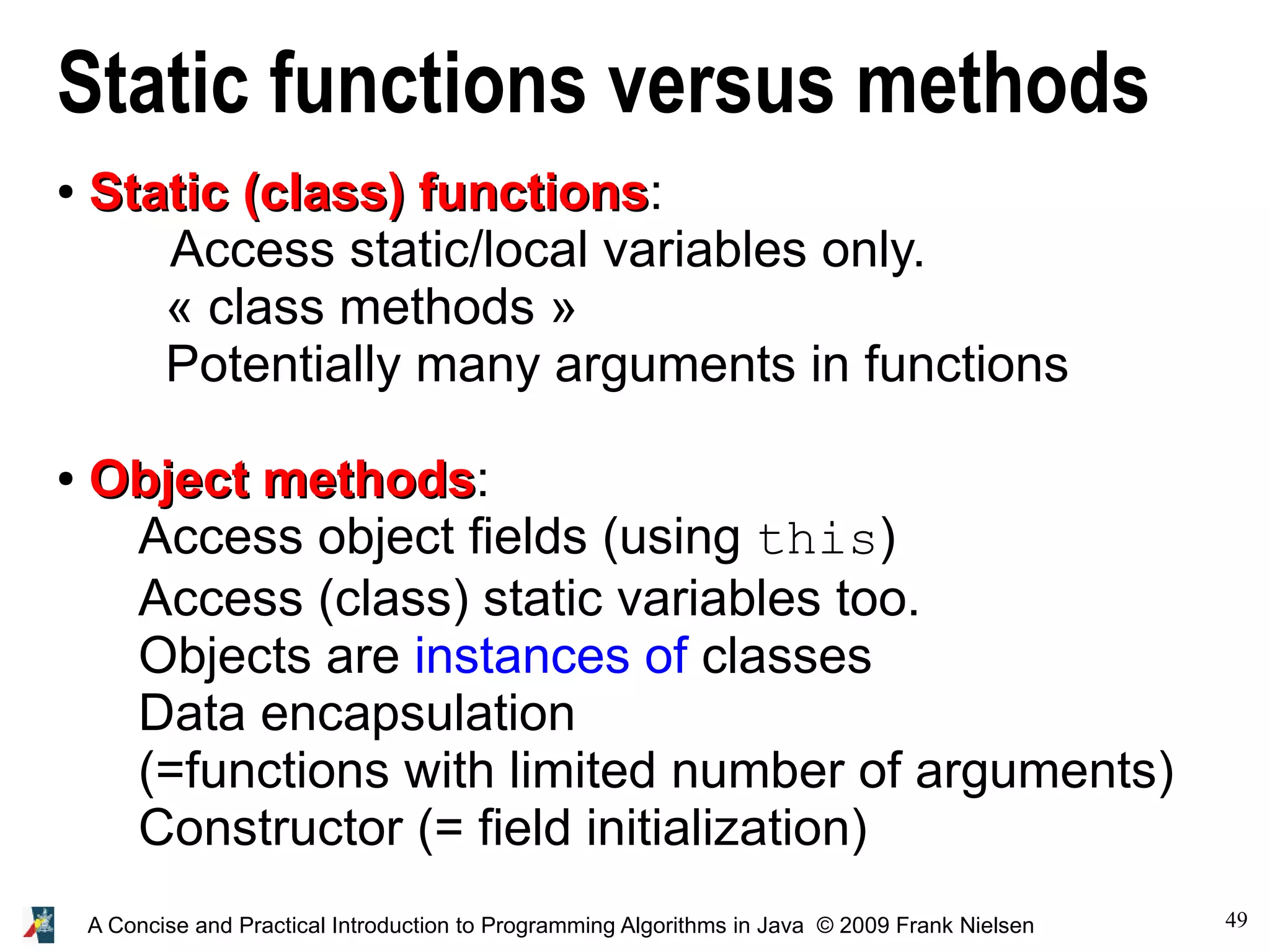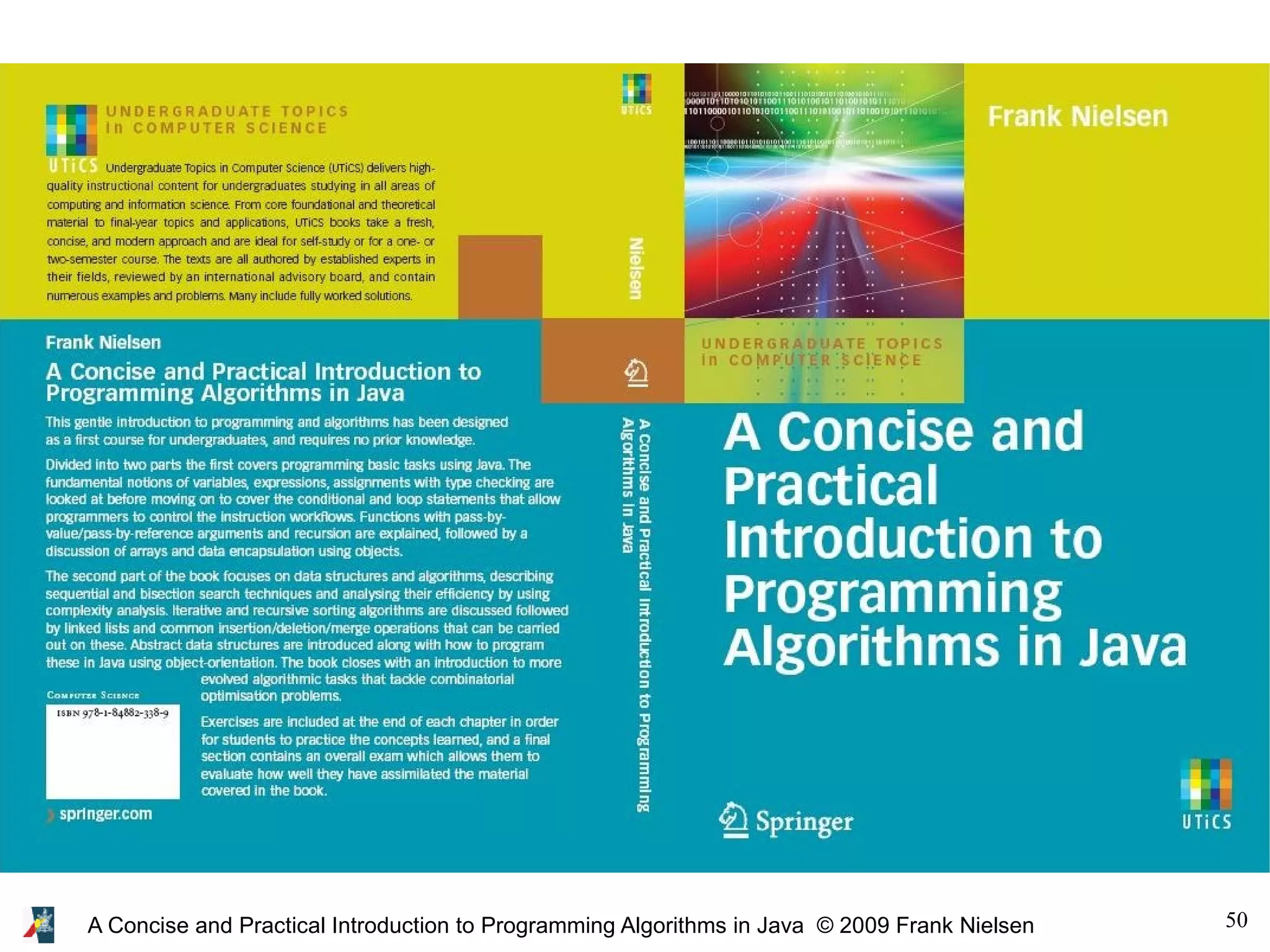The document provides a comprehensive introduction to programming algorithms in Java, focusing on data structures such as queues (FIFO), heaps, and object methods. It explains the mechanics of manipulating these structures, offers code examples, and discusses object-oriented programming principles. Key aspects include queue management, heap properties and operations, non-static methods, and implementing lists in an object-oriented style.
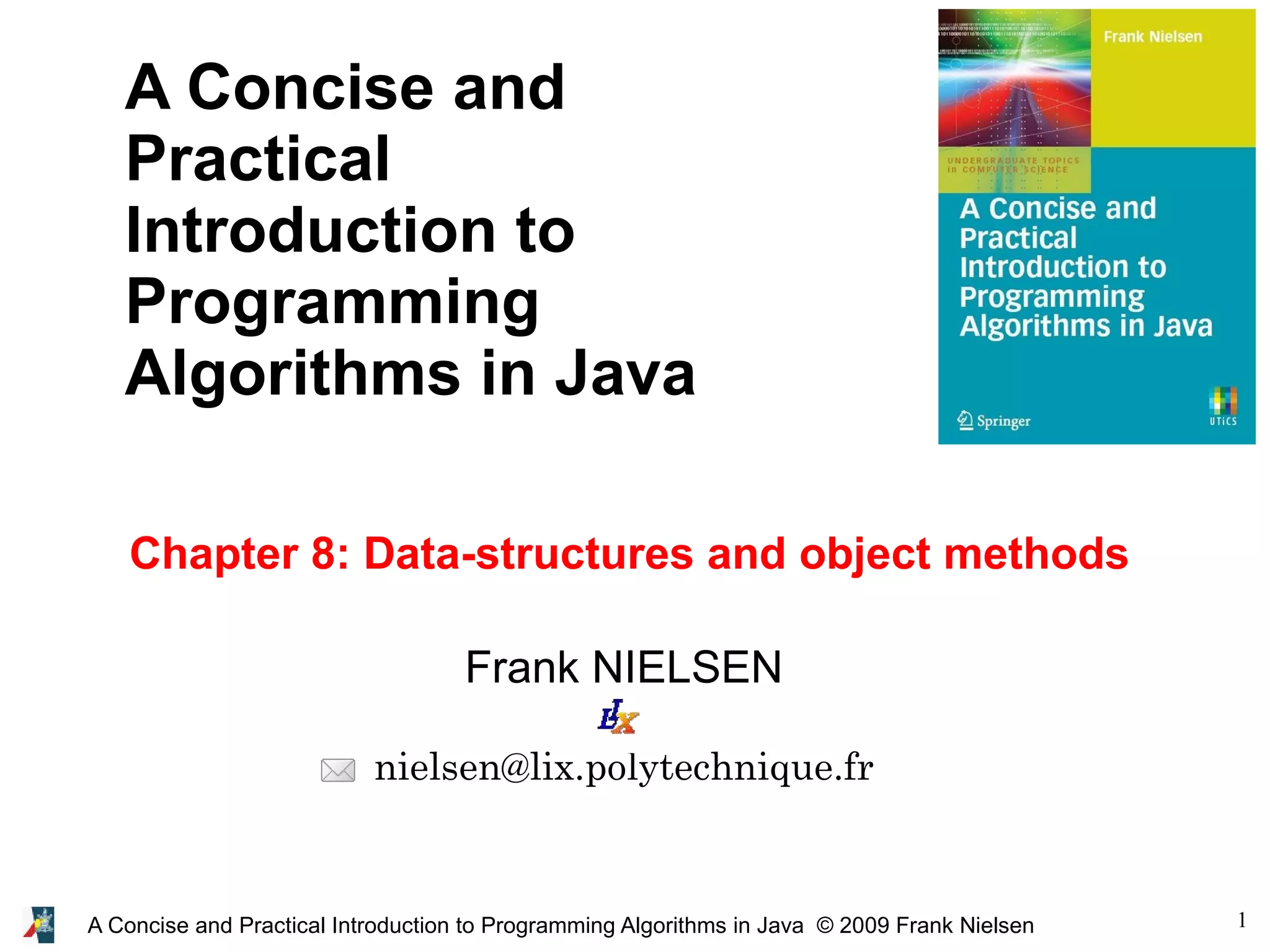
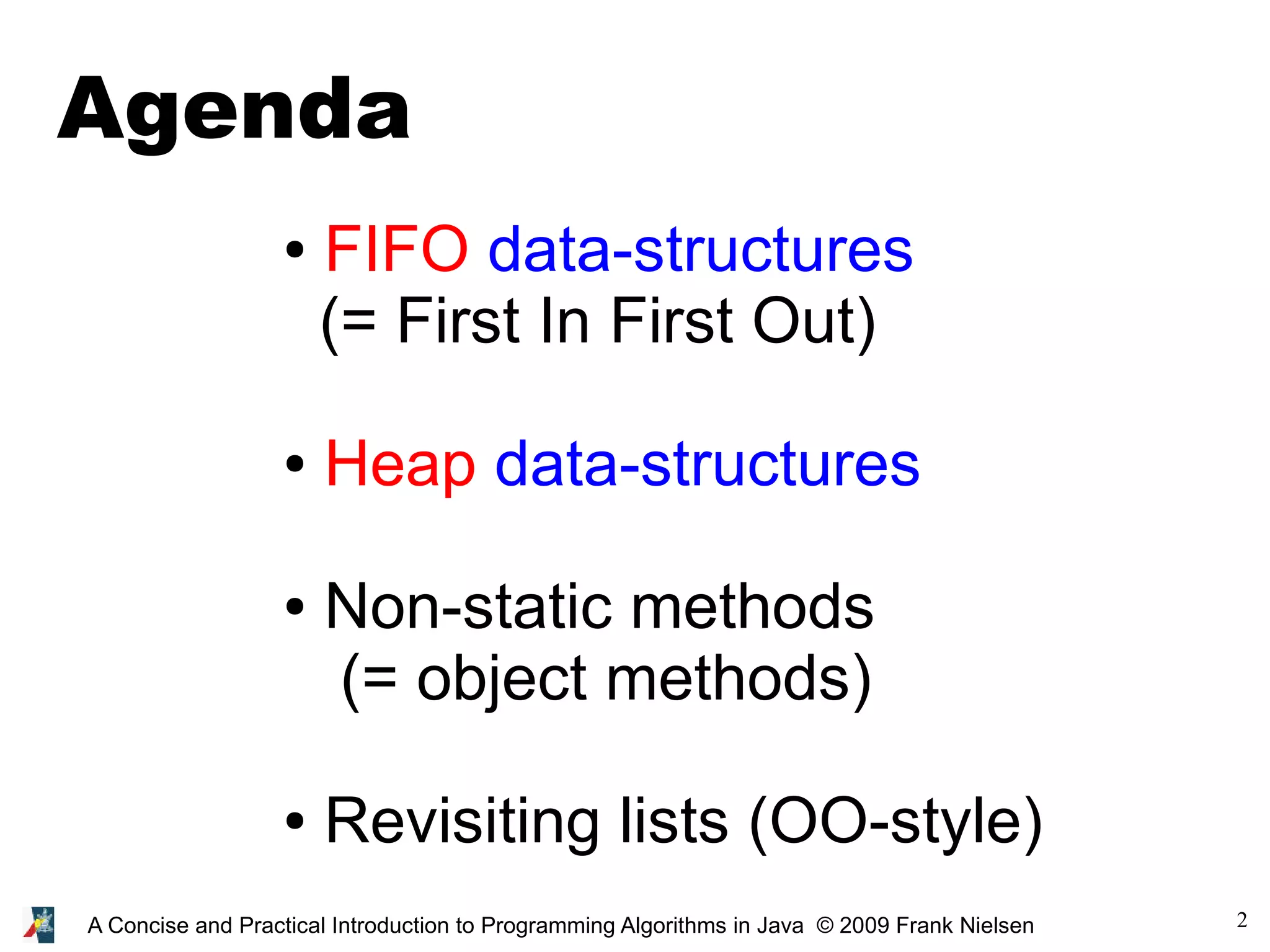
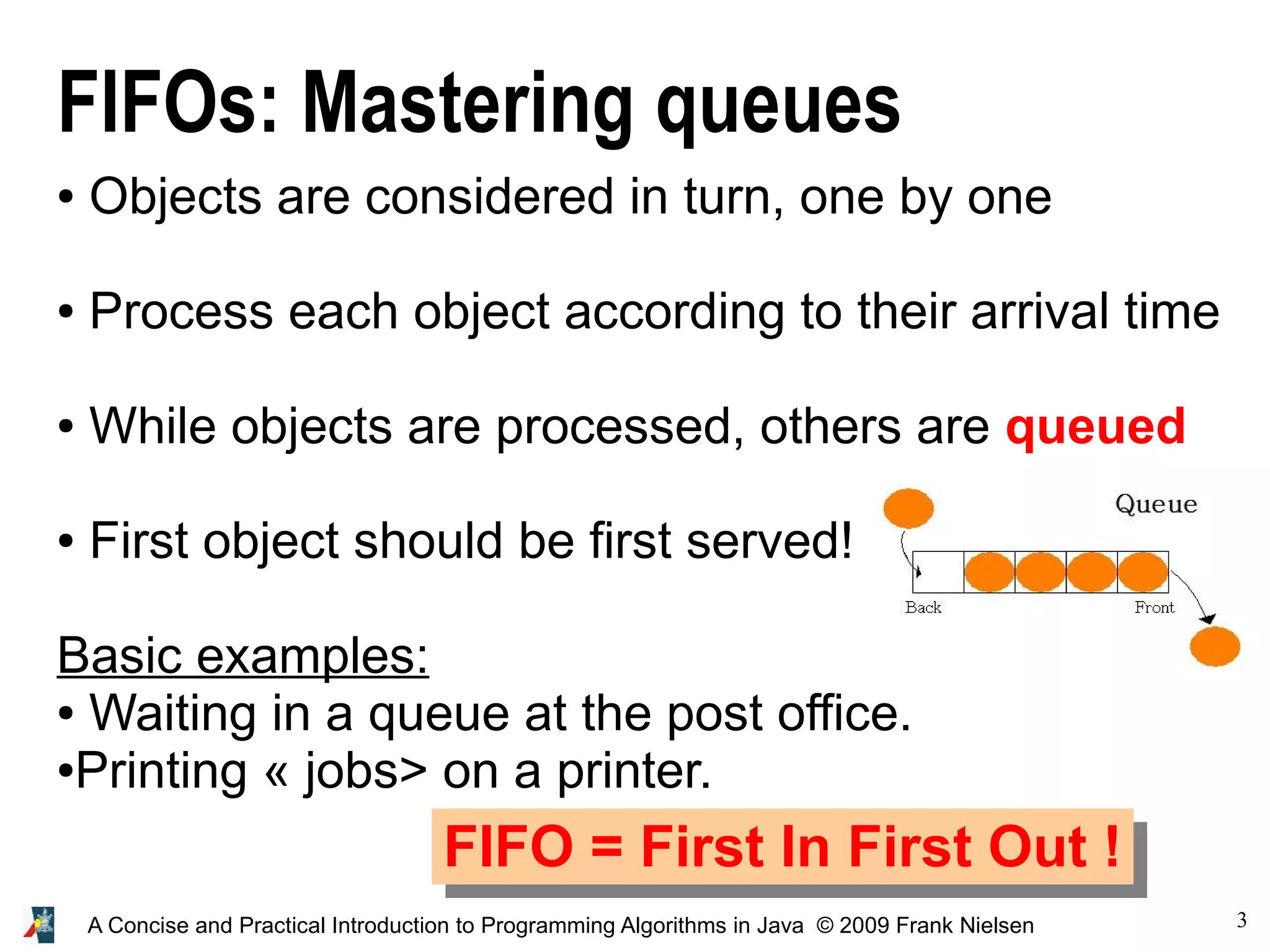
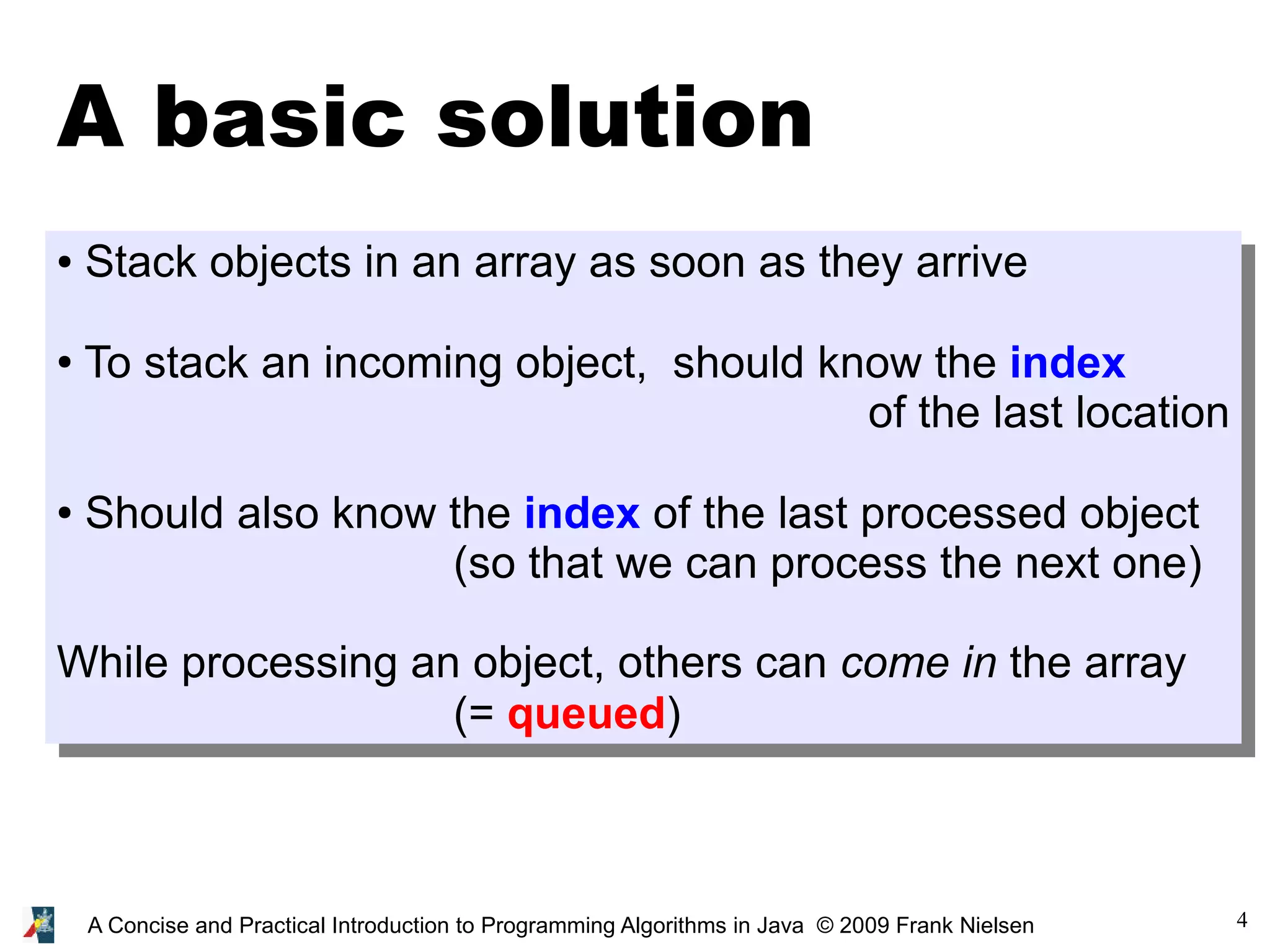
![5A Concise and Practical Introduction to Programming Algorithms in Java © 2009 Frank Nielsen A basic solution ● An array: container array for storing objects ● Two indices: lastProcessed and freePlace ● To add an object x, we do array[freePlace]=x and we then increment: freePlace++ ● To process an object, we increment lastProcessed and we process array[lastProcessed]](https://image.slidesharecdn.com/programmingalgorithmsjava-8-140701005550-phpapp01/75/chapter-8-A-Concise-and-Practical-Introduction-to-Programming-Algorithms-in-Java-5-2048.jpg)
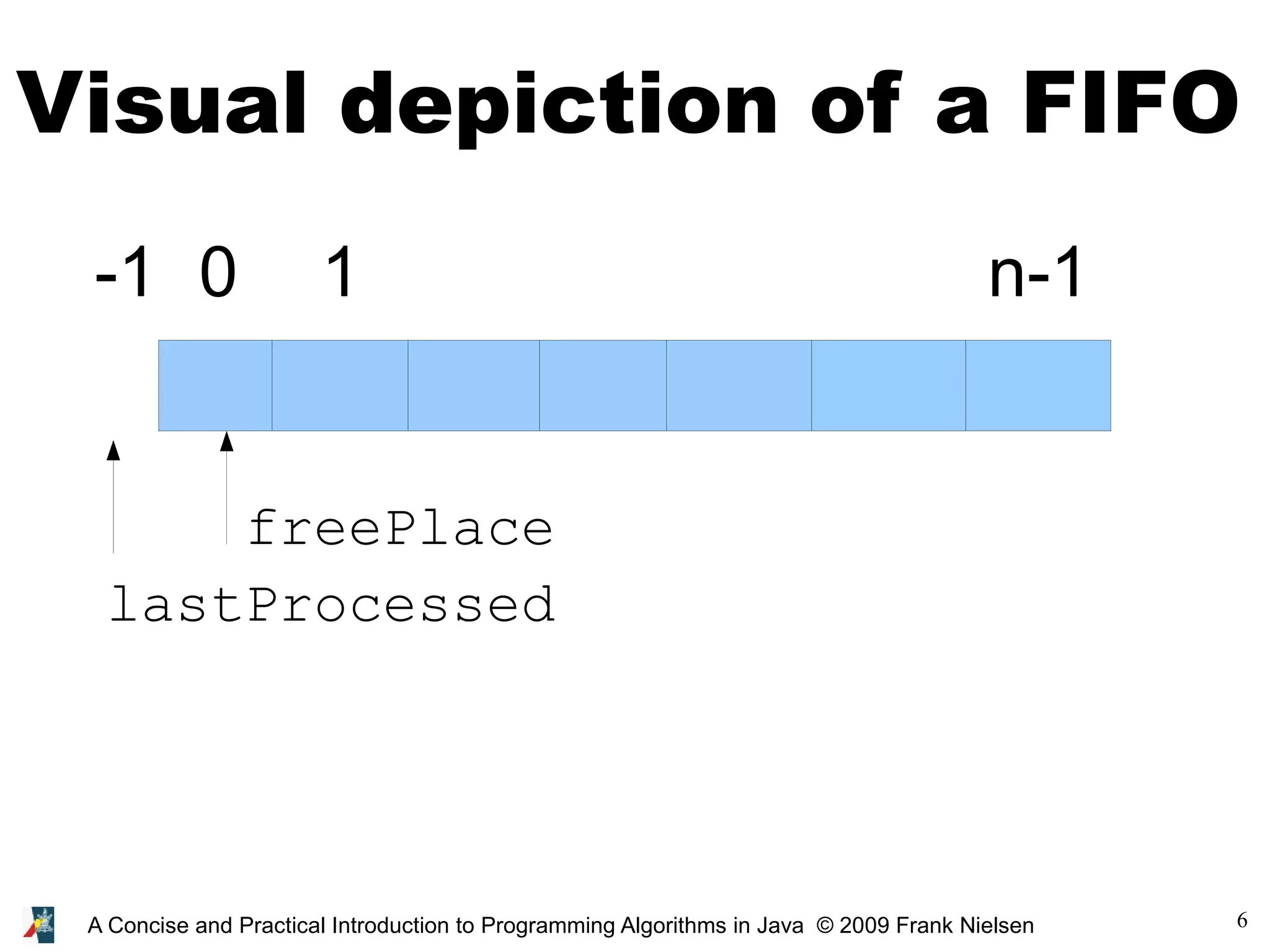
![7A Concise and Practical Introduction to Programming Algorithms in Java © 2009 Frank Nielsen lastProcessed freePlace O1 FIFO: Queuing objects array[freePlace++]=O1;](https://image.slidesharecdn.com/programmingalgorithmsjava-8-140701005550-phpapp01/75/chapter-8-A-Concise-and-Practical-Introduction-to-Programming-Algorithms-in-Java-7-2048.jpg)
![8A Concise and Practical Introduction to Programming Algorithms in Java © 2009 Frank Nielsen O1 Queuing another object O2 lastProcessed freePlace array[freePlace++]=O2;](https://image.slidesharecdn.com/programmingalgorithmsjava-8-140701005550-phpapp01/75/chapter-8-A-Concise-and-Practical-Introduction-to-Programming-Algorithms-in-Java-8-2048.jpg)
![9A Concise and Practical Introduction to Programming Algorithms in Java © 2009 Frank Nielsen O1 Processing and queuing O2 O3 lastProcessed freePlace Process(array[lastProcessed++]); array[freePlace++]=O3; Processing and queuing can be done in parallel using threads](https://image.slidesharecdn.com/programmingalgorithmsjava-8-140701005550-phpapp01/75/chapter-8-A-Concise-and-Practical-Introduction-to-Programming-Algorithms-in-Java-9-2048.jpg)
![10A Concise and Practical Introduction to Programming Algorithms in Java © 2009 Frank Nielsen Programming queues static int lastProcessed=-1; static int freePlace=0; static double[] container=new double[1000]; static void add(double Object) { if (freePlace<1000) {container[freePlace]=Object; freePlace++;} } static double process() { if (freePlace-lastProcessed>1) { // Do something here lastProcessed++; return container[lastProcessed]; } else return -1.0; // special return code: no process }](https://image.slidesharecdn.com/programmingalgorithmsjava-8-140701005550-phpapp01/75/chapter-8-A-Concise-and-Practical-Introduction-to-Programming-Algorithms-in-Java-10-2048.jpg)
![11A Concise and Practical Introduction to Programming Algorithms in Java © 2009 Frank Nielsen class QueueDouble { static int lastProcessed=-1; static int freePlace=0; // Max objects is set to 1000 static double[] container=new double[1000]; // Stack in FIFO order static void add(double a) {...} // Process in FIFO order static double process() {...} public static void main(String[] arg) { System.out.println("Queue demo:"); add(3.0); add(5.0); add(7.0); System.out.println(process()); System.out.println(process()); System.out.println(process()); System.out.println(process()); System.out.println(process()); } FIFO: First In First Out](https://image.slidesharecdn.com/programmingalgorithmsjava-8-140701005550-phpapp01/75/chapter-8-A-Concise-and-Practical-Introduction-to-Programming-Algorithms-in-Java-11-2048.jpg)
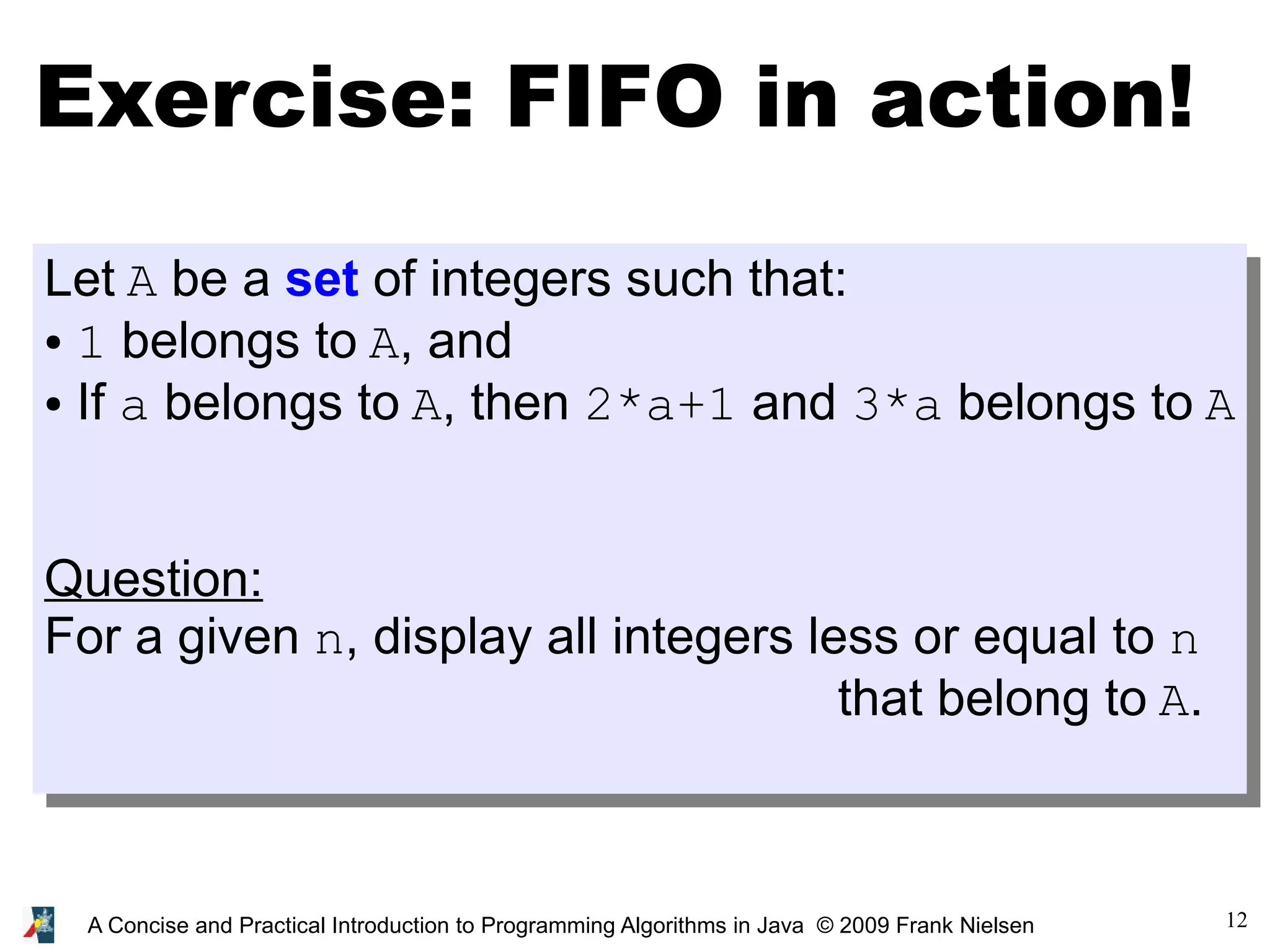
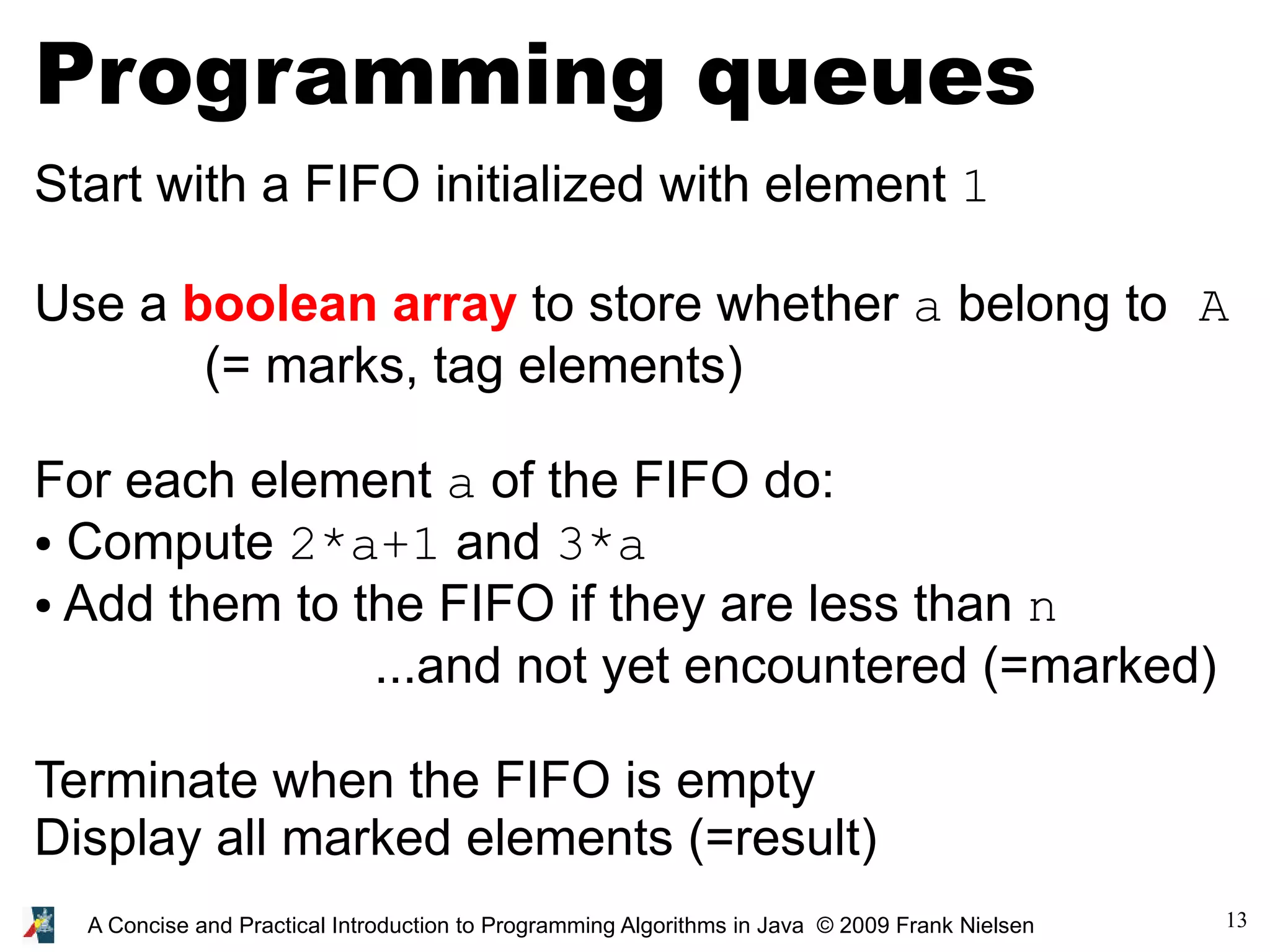
![14A Concise and Practical Introduction to Programming Algorithms in Java © 2009 Frank Nielsen final static int n=1000; static int lastProcessed=-1; static int freePlace=0; static int[] container=new int[n]; static boolean[] mark=new boolean[n]; static void add(int a) {if (freePlace<n) {container[freePlace]=a;freePlace++;}} static boolean Empty() { return ((freePlace-lastProcessed)==1); } static void process() {int a; lastProcessed++; a=container[lastProcessed]; if (a<n) mark[a]=true; if (2*a+1<n) add(2*a+1); if (3*a<n) add(3*a); } public static void main(String[] arg) {int i; for(i=0;i<n;i++) mark[i]=false; add(1); while(!Empty()) process(); for(i=0;i<n;i++) {if (mark[i]) System.out.print(i+" ");} System.out.println(""); }](https://image.slidesharecdn.com/programmingalgorithmsjava-8-140701005550-phpapp01/75/chapter-8-A-Concise-and-Practical-Introduction-to-Programming-Algorithms-in-Java-14-2048.jpg)
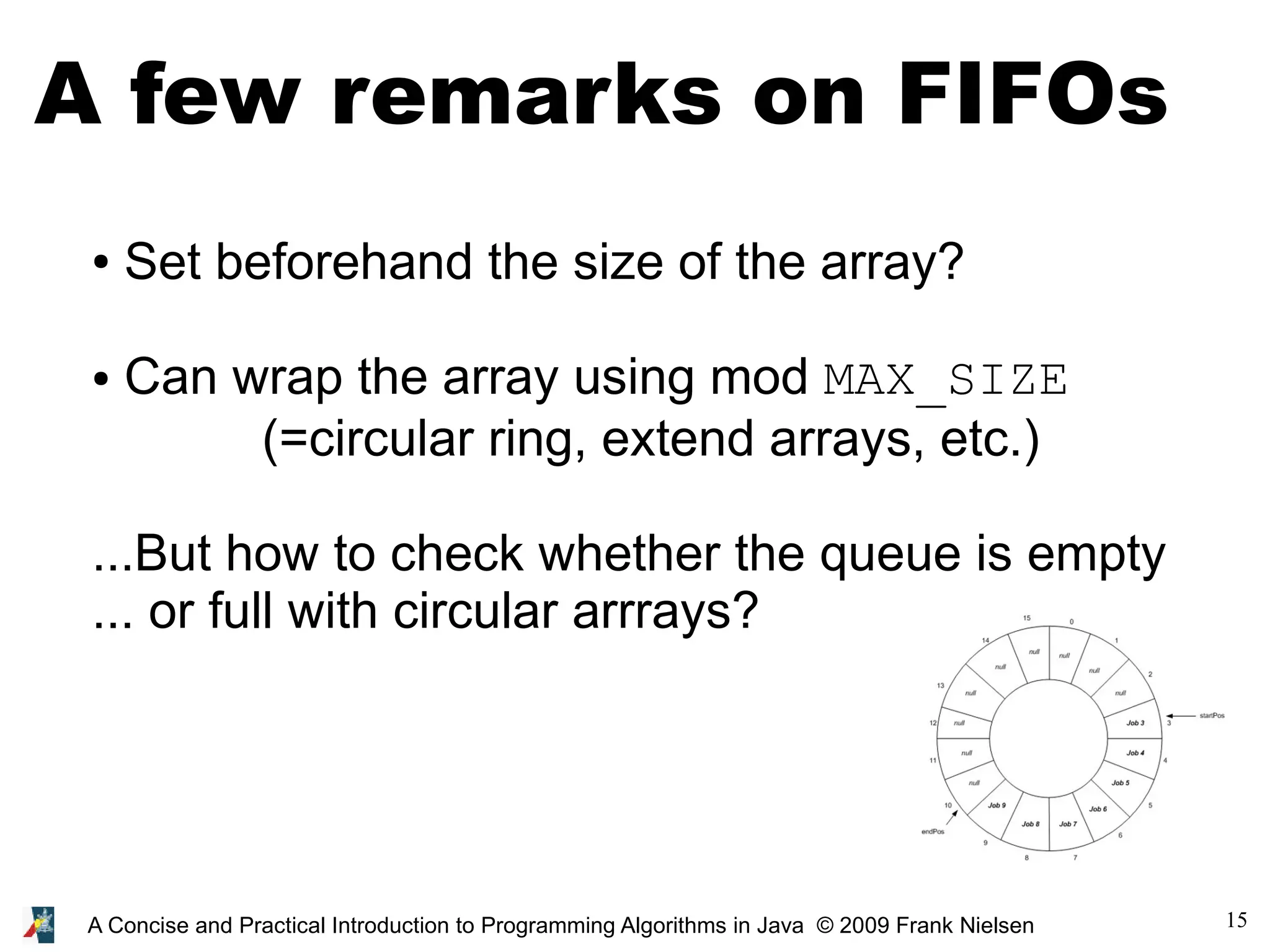
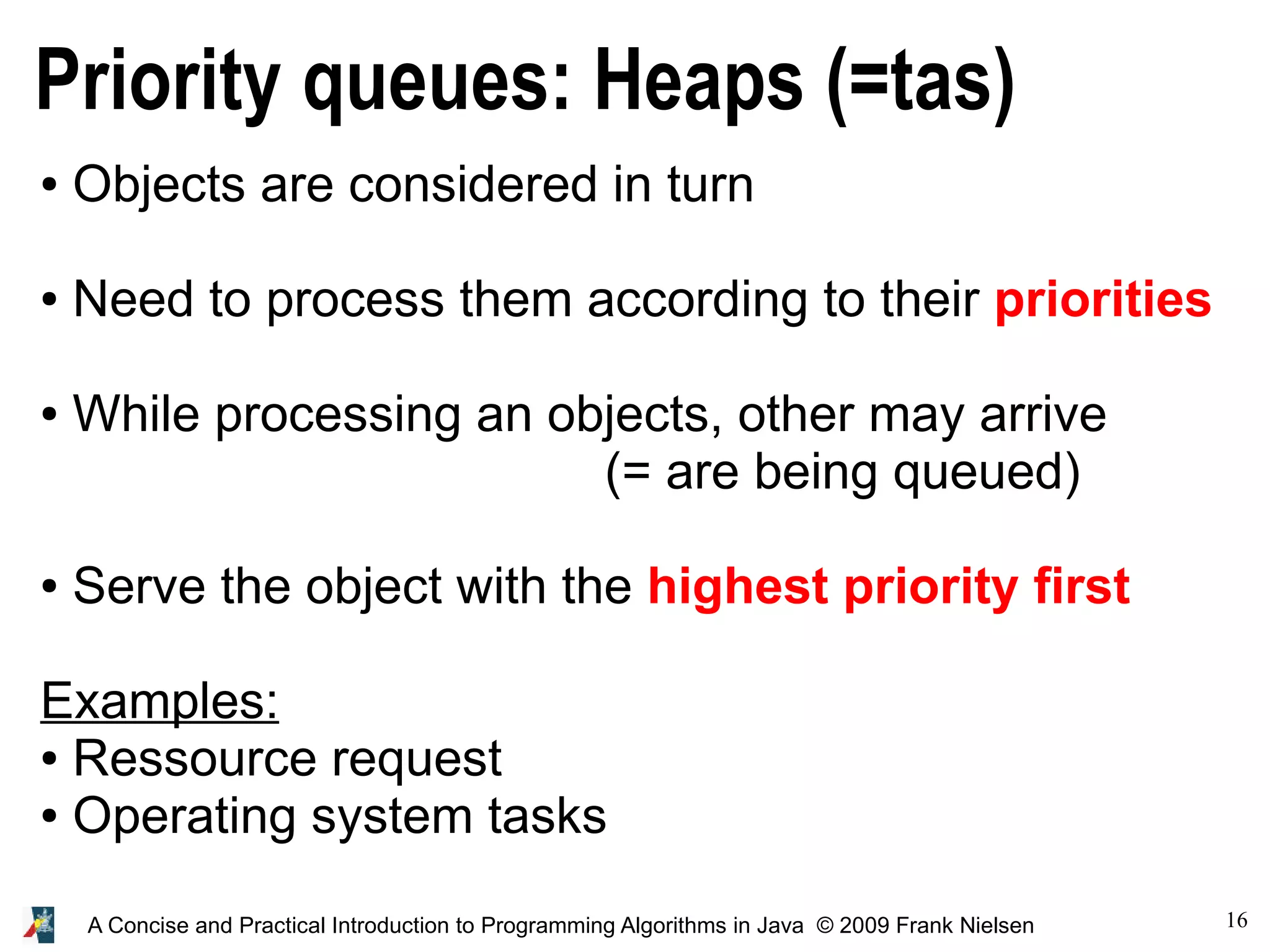
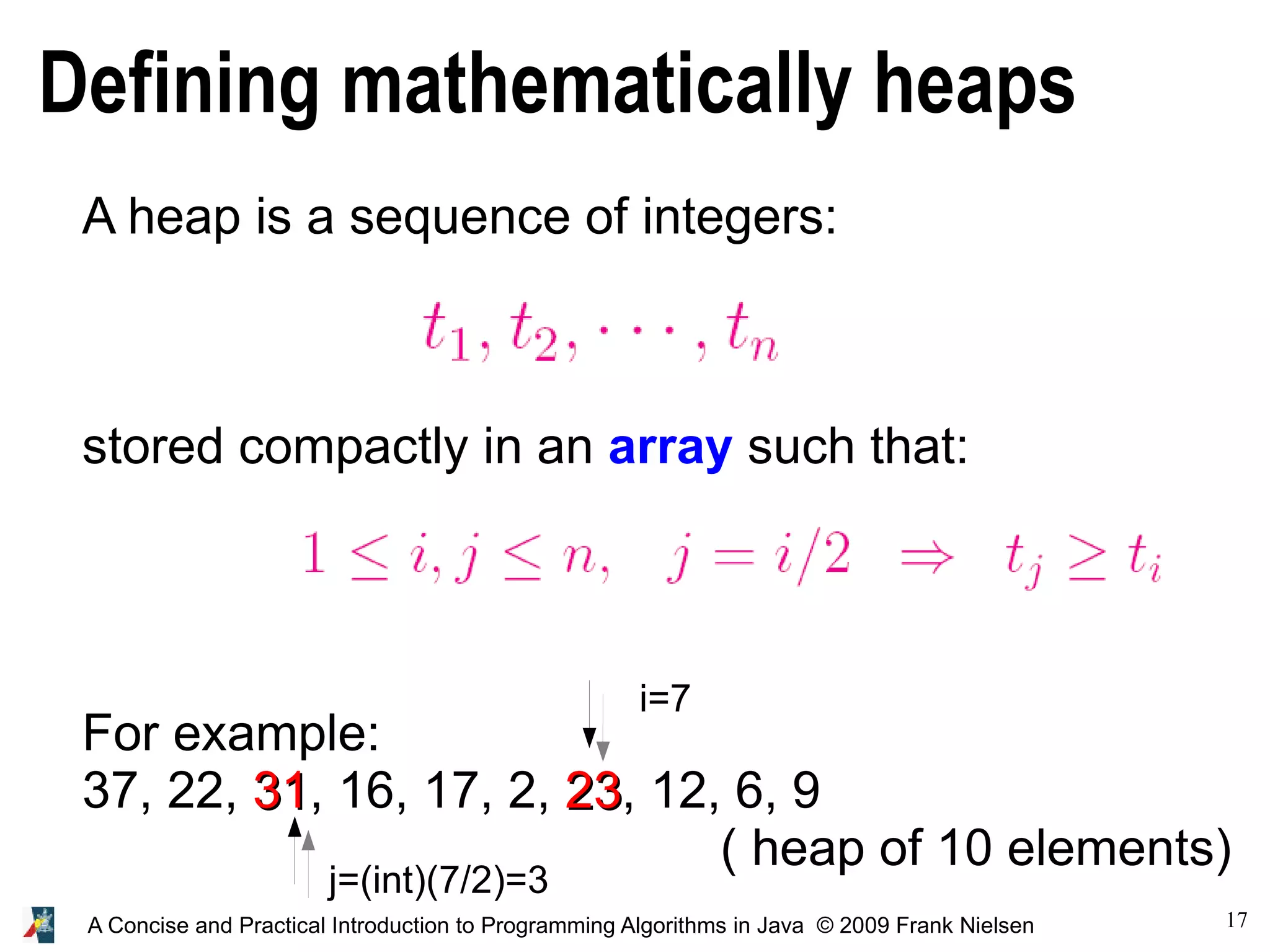
![18A Concise and Practical Introduction to Programming Algorithms in Java © 2009 Frank Nielsen Drawing a heap ● Draw a heap as a tree (=special graph Vertex/Edge) ● Each node i contains a value t[i] and has 0, 1 or 2 siblings that contain nodes of values less than its parent ● Node i has children 2i and 2i+1 t[i] 37, 22, 31, 16, 17, 2, 23, 12, 6, 9: Read layer by layer, from the root til the leaves](https://image.slidesharecdn.com/programmingalgorithmsjava-8-140701005550-phpapp01/75/chapter-8-A-Concise-and-Practical-Introduction-to-Programming-Algorithms-in-Java-18-2048.jpg)
![19A Concise and Practical Introduction to Programming Algorithms in Java © 2009 Frank Nielsen Storing and manipulating heaps Easy to code with a linear arraypublic class Heap { int size; int [] label; static final int MAX_SIZE=10000; Heap() { this.size=0; this.label=new int[MAX_SIZE]; } public static void main(String[] args) {} }](https://image.slidesharecdn.com/programmingalgorithmsjava-8-140701005550-phpapp01/75/chapter-8-A-Concise-and-Practical-Introduction-to-Programming-Algorithms-in-Java-19-2048.jpg)
![20A Concise and Practical Introduction to Programming Algorithms in Java © 2009 Frank Nielsen Fundamental property of heaps Largest value is stored at the root of the tree, namely at the first element of the array. static int maxHeap(Heap h) { return h.label[0]; }](https://image.slidesharecdn.com/programmingalgorithmsjava-8-140701005550-phpapp01/75/chapter-8-A-Concise-and-Practical-Introduction-to-Programming-Algorithms-in-Java-20-2048.jpg)
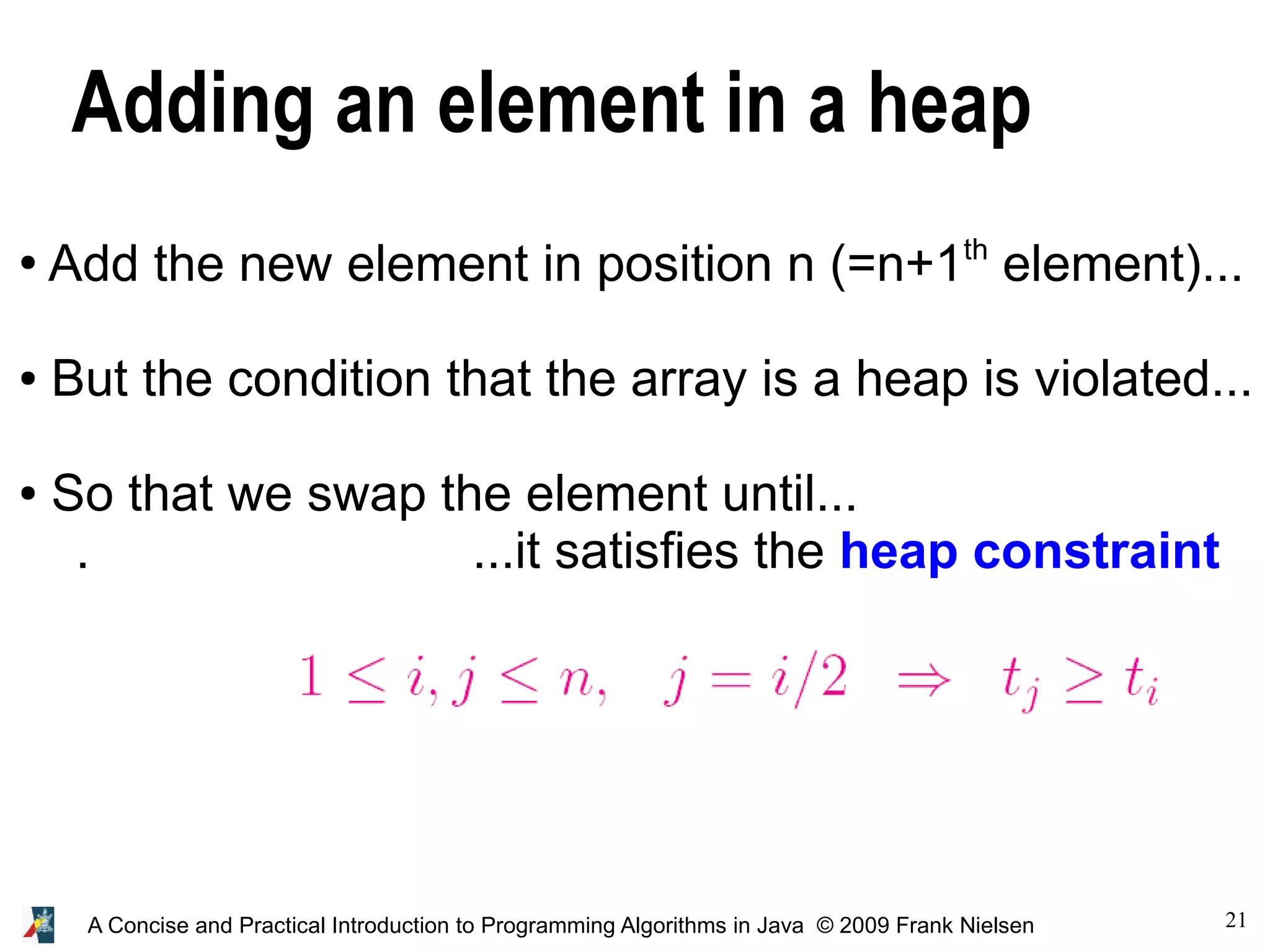
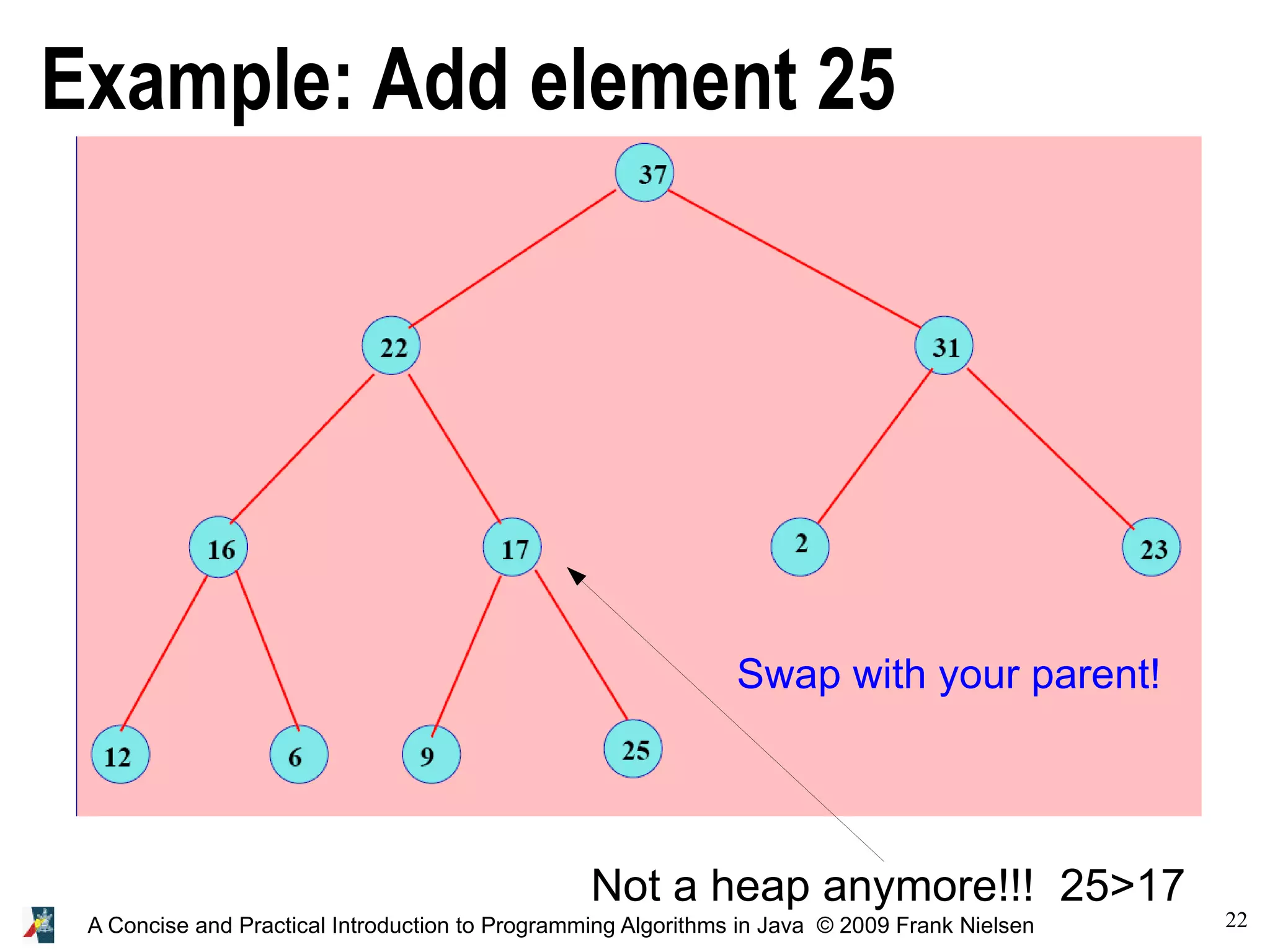
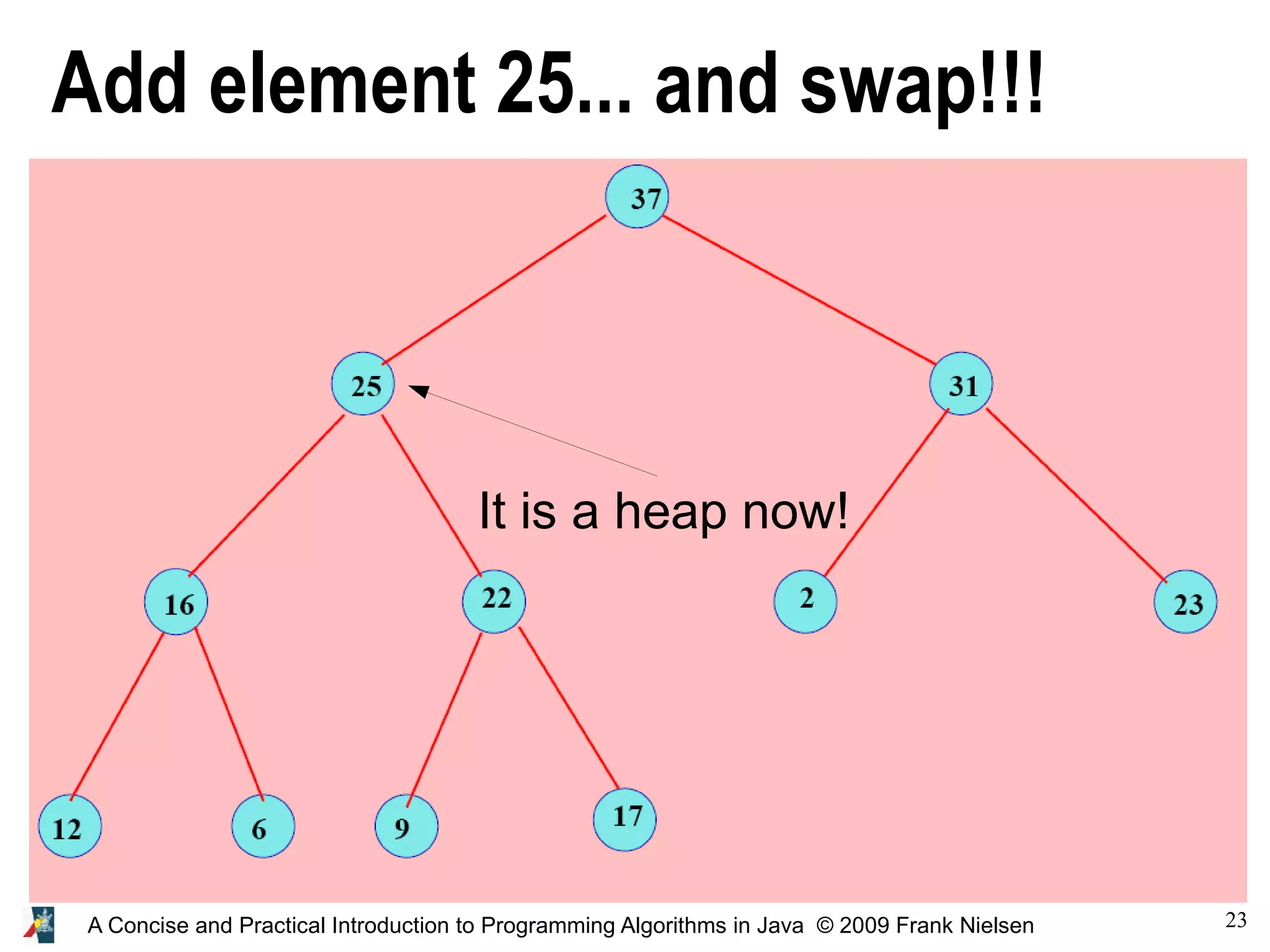
![24A Concise and Practical Introduction to Programming Algorithms in Java © 2009 Frank Nielsen Adding an element in the heap static void addHeap(int element, Heap h) { h.label[h.size]=element; h.size++; int i=h.size; int j=i/2; while (i>1 && h.label[i]>h.label[j]) { int tmp=h.label[i]; h.label[i]=h.label[j]; h.label[j]=tmp; i=j; // swap j=i/2; } }](https://image.slidesharecdn.com/programmingalgorithmsjava-8-140701005550-phpapp01/75/chapter-8-A-Concise-and-Practical-Introduction-to-Programming-Algorithms-in-Java-24-2048.jpg)
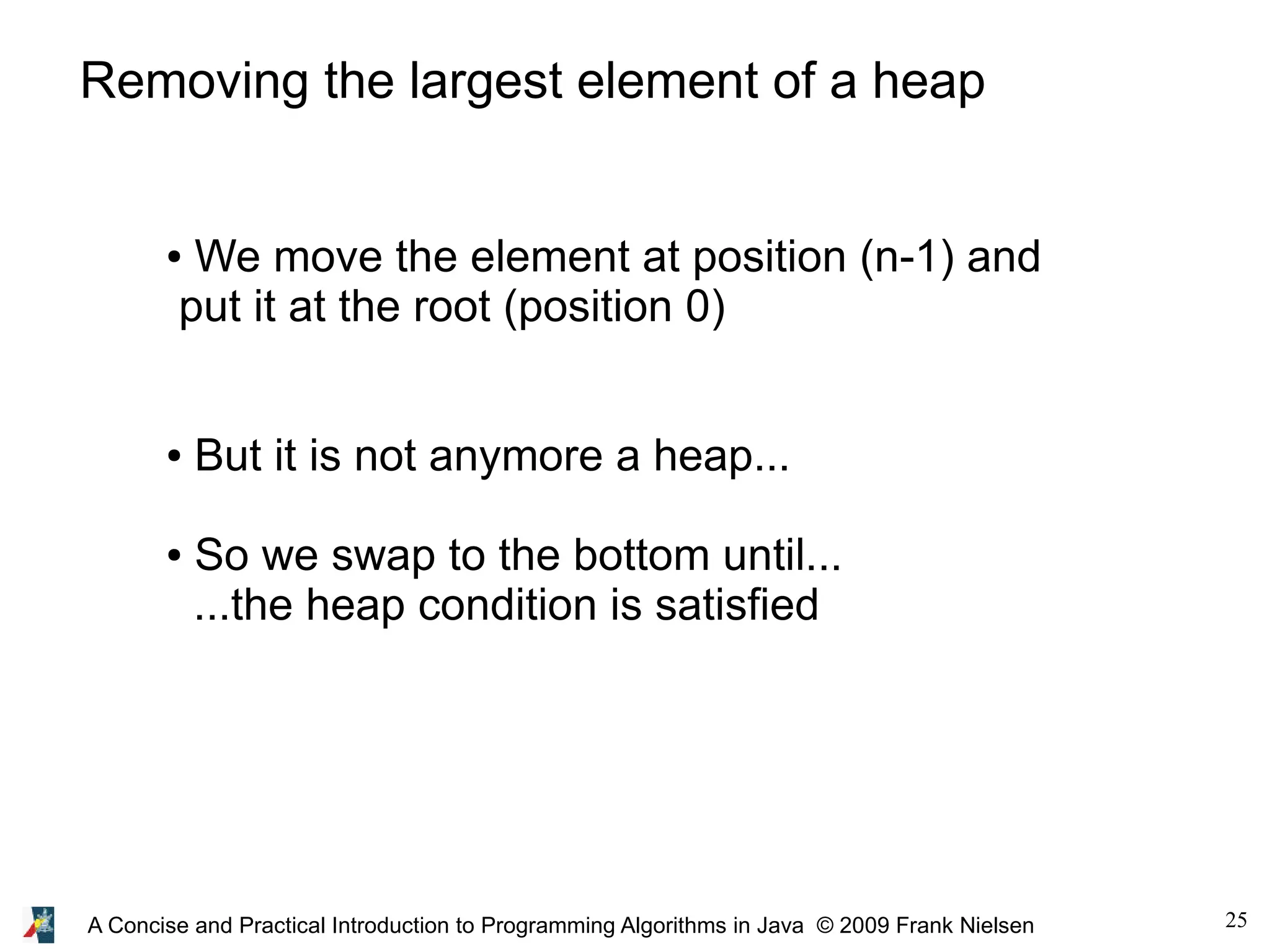
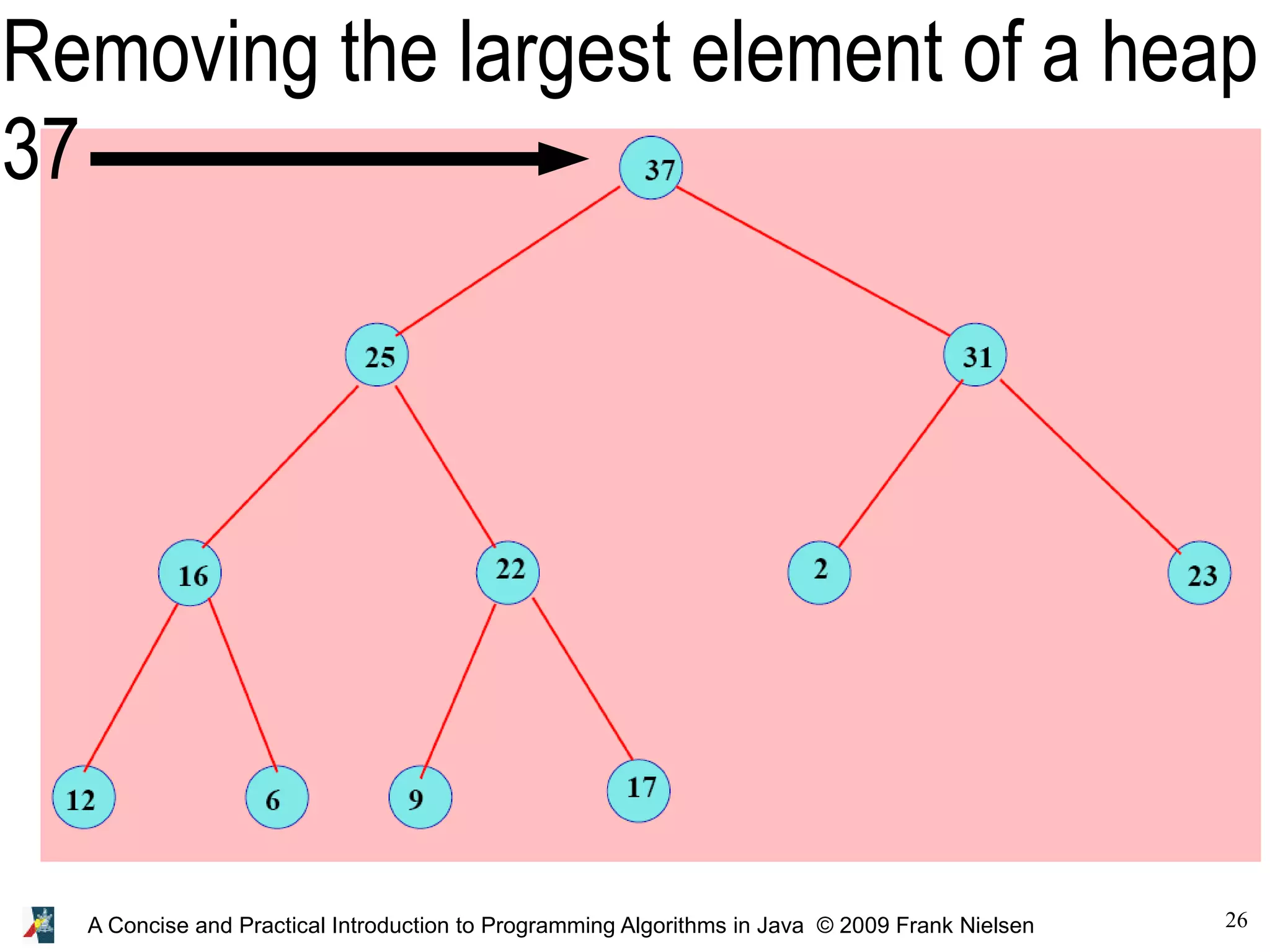
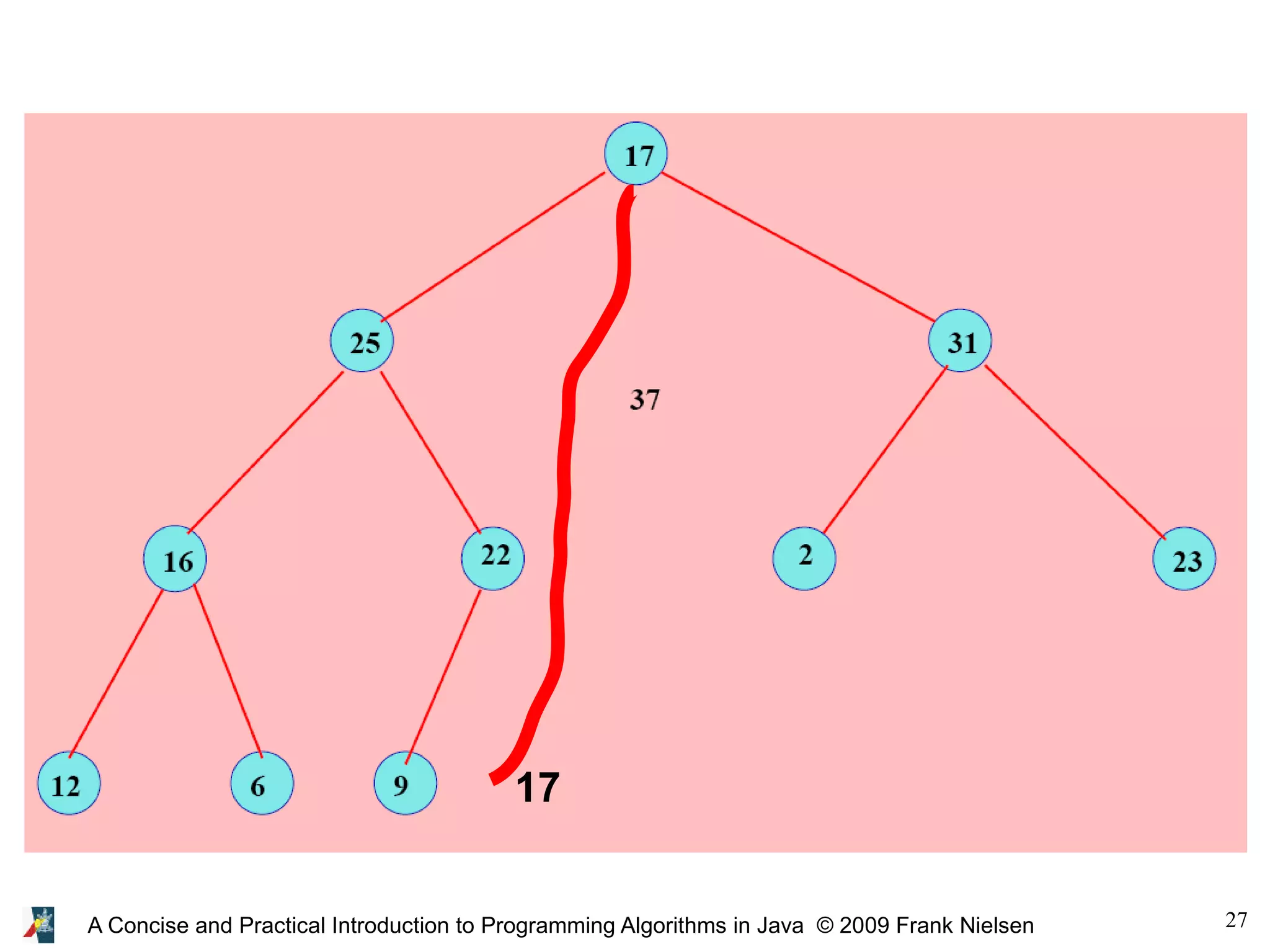
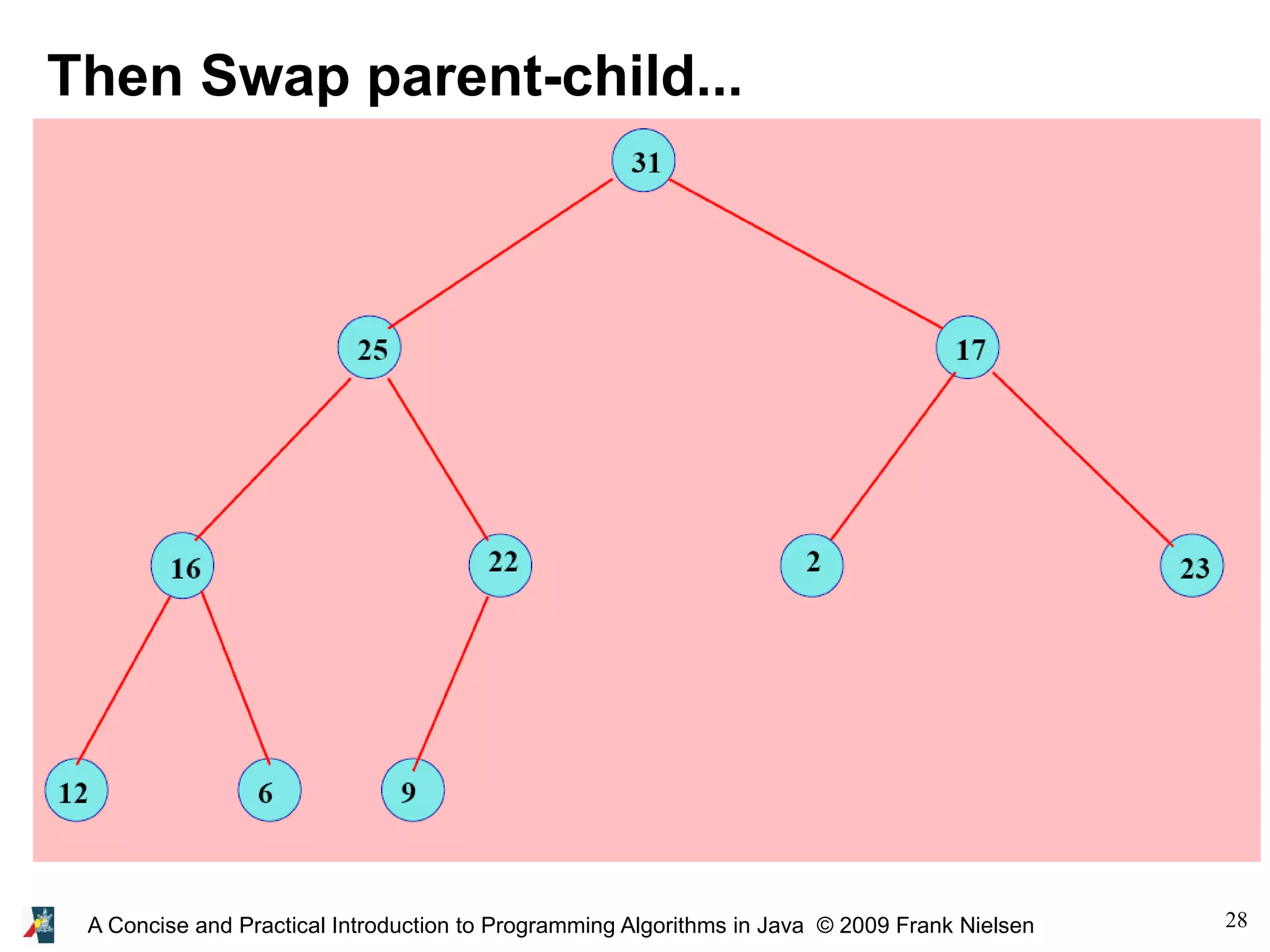
![29A Concise and Practical Introduction to Programming Algorithms in Java © 2009 Frank Nielsen static int removeHeap(int element, Heap h) { h.label[0]=h.label[h.size-1]; h.size--; int i=0,j,k,tmp; while(2*i<=h.size) { j=2*i; if (j<h.size && h.label[j+1]>h.label[j]) j++; if (h.label[i]<h.label[j]) {tmp=h.label[i]; h.label[i]=h.label[j]; h.label[j]=tmp; i=j;} else break; } return h.label[h.size-1]; } Removing the largest element of a heap](https://image.slidesharecdn.com/programmingalgorithmsjava-8-140701005550-phpapp01/75/chapter-8-A-Concise-and-Practical-Introduction-to-Programming-Algorithms-in-Java-29-2048.jpg)
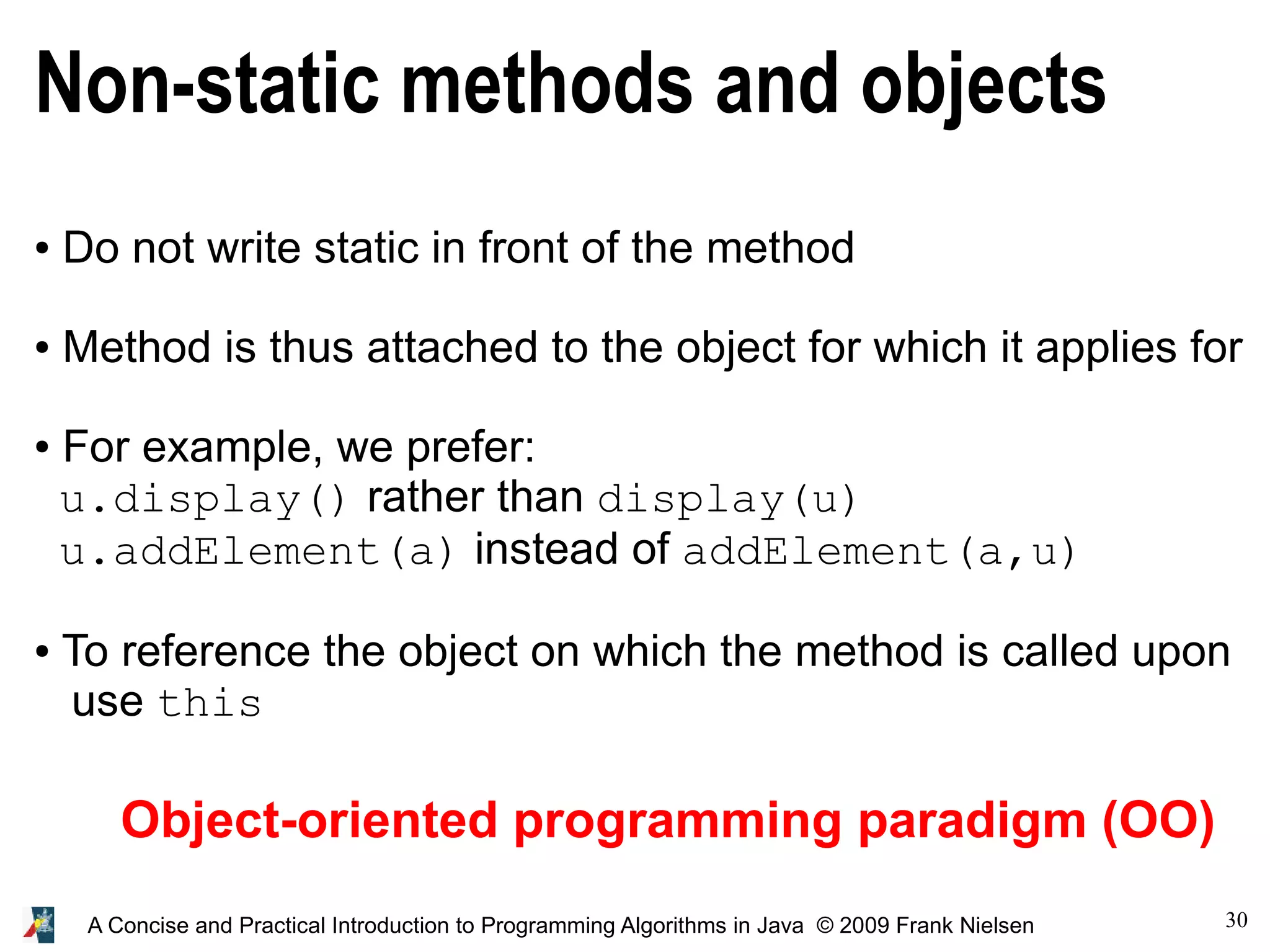
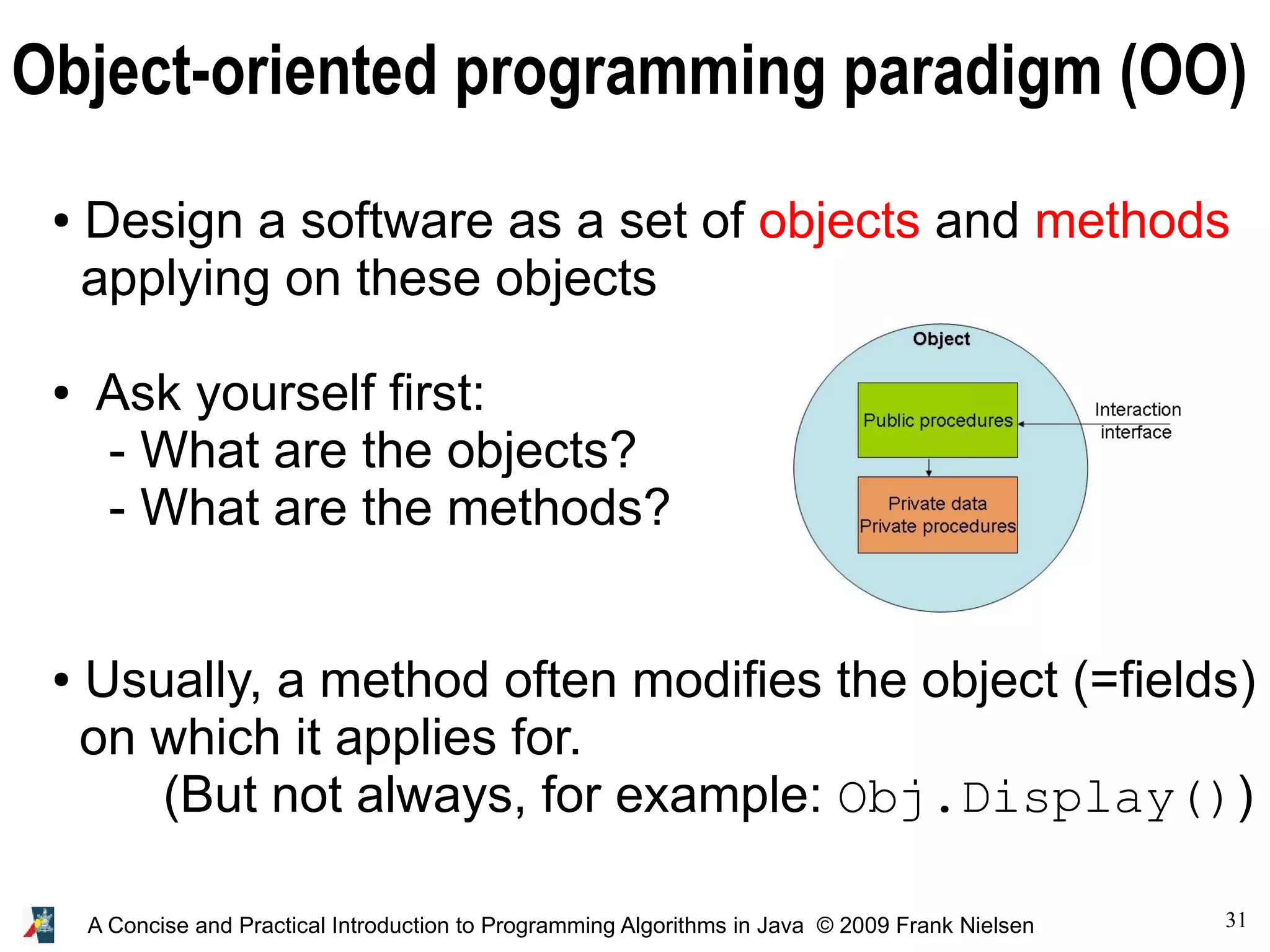
![32A Concise and Practical Introduction to Programming Algorithms in Java © 2009 Frank Nielsen OO style: object methods versus static functions class Box { double width, height, depth; Box(double w, double h, double d) { this.width=w; this.height=h; this.depth=d; } double Volume() {return this.width*this.height*this.depth;} } class OOstyle { static double Volume(Box box) {return box.width*box.height*box.depth;} public static void main(String[] s) { Box myBox=new Box(5,2,1); System.out.println("Volume by static method:"+Volume(myBox)); System.out.println("Volume by object method:"+myBox.Volume()); } } Object (non-static) method](https://image.slidesharecdn.com/programmingalgorithmsjava-8-140701005550-phpapp01/75/chapter-8-A-Concise-and-Practical-Introduction-to-Programming-Algorithms-in-Java-32-2048.jpg)
![33A Concise and Practical Introduction to Programming Algorithms in Java © 2009 Frank Nielsen class Toolkit { static final double PI=3.14; static double Square(double x) {return x*x;} static double Cubic(double x) {return x*x*x;} } class StaticFuncStyle { public static void main(String[] s) { double radius=0.5; double volSphere=(4/3.0)*Toolkit.PI*Toolkit.Cubic(radius); double areaDisk=Toolkit.PI*Toolkit.Square(radius); } } Static methods are useful for defining: - Constants - Basic functions ....in a library.](https://image.slidesharecdn.com/programmingalgorithmsjava-8-140701005550-phpapp01/75/chapter-8-A-Concise-and-Practical-Introduction-to-Programming-Algorithms-in-Java-33-2048.jpg)
![34A Concise and Practical Introduction to Programming Algorithms in Java © 2009 Frank Nielsen Heaps revisited in Object-Oriented style int maxHeap() { return this.label[0]; } void add(int element) { ... } void removeTop() { ... } Observe that the keyword static has disappeared](https://image.slidesharecdn.com/programmingalgorithmsjava-8-140701005550-phpapp01/75/chapter-8-A-Concise-and-Practical-Introduction-to-Programming-Algorithms-in-Java-34-2048.jpg)
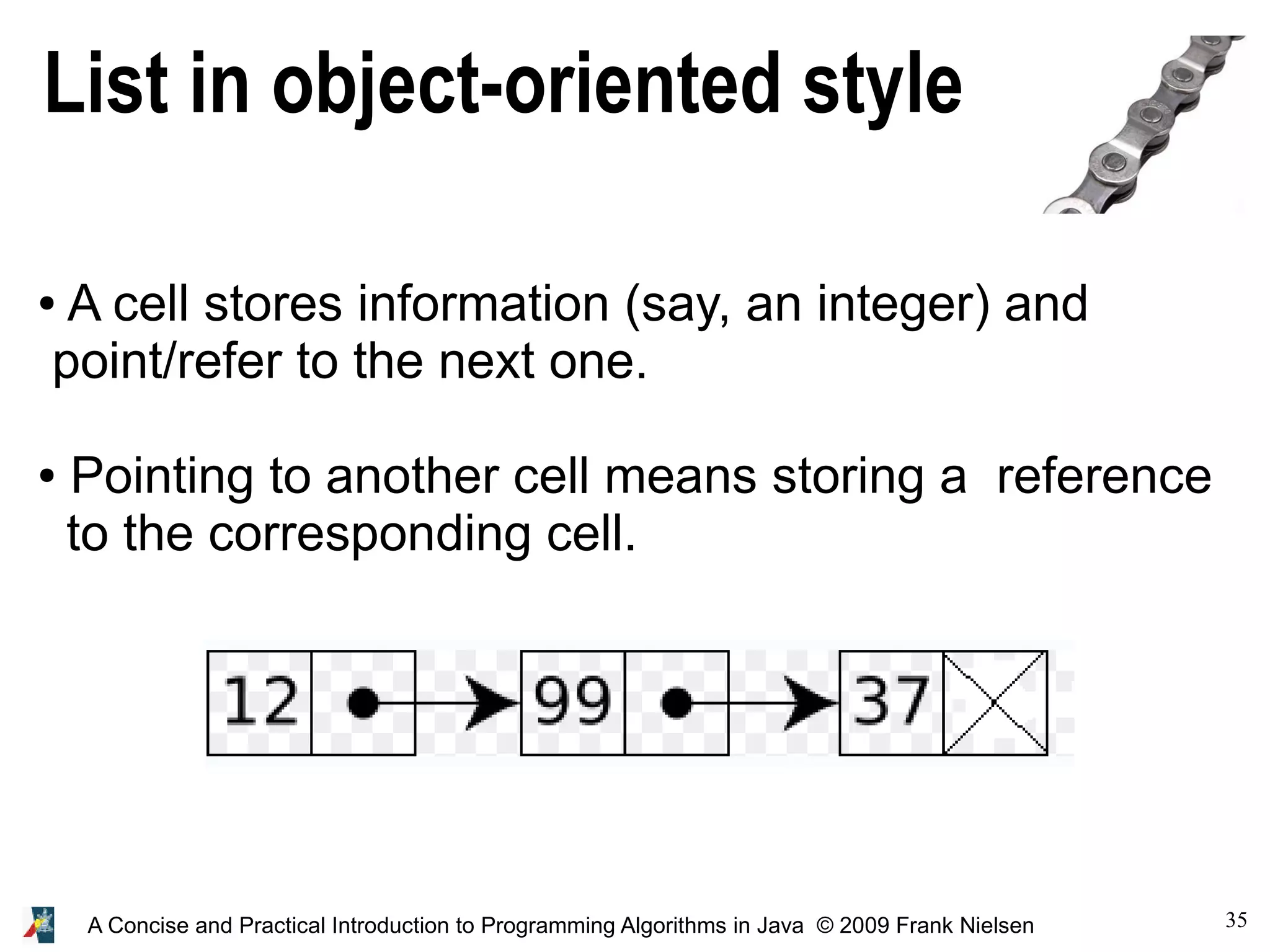
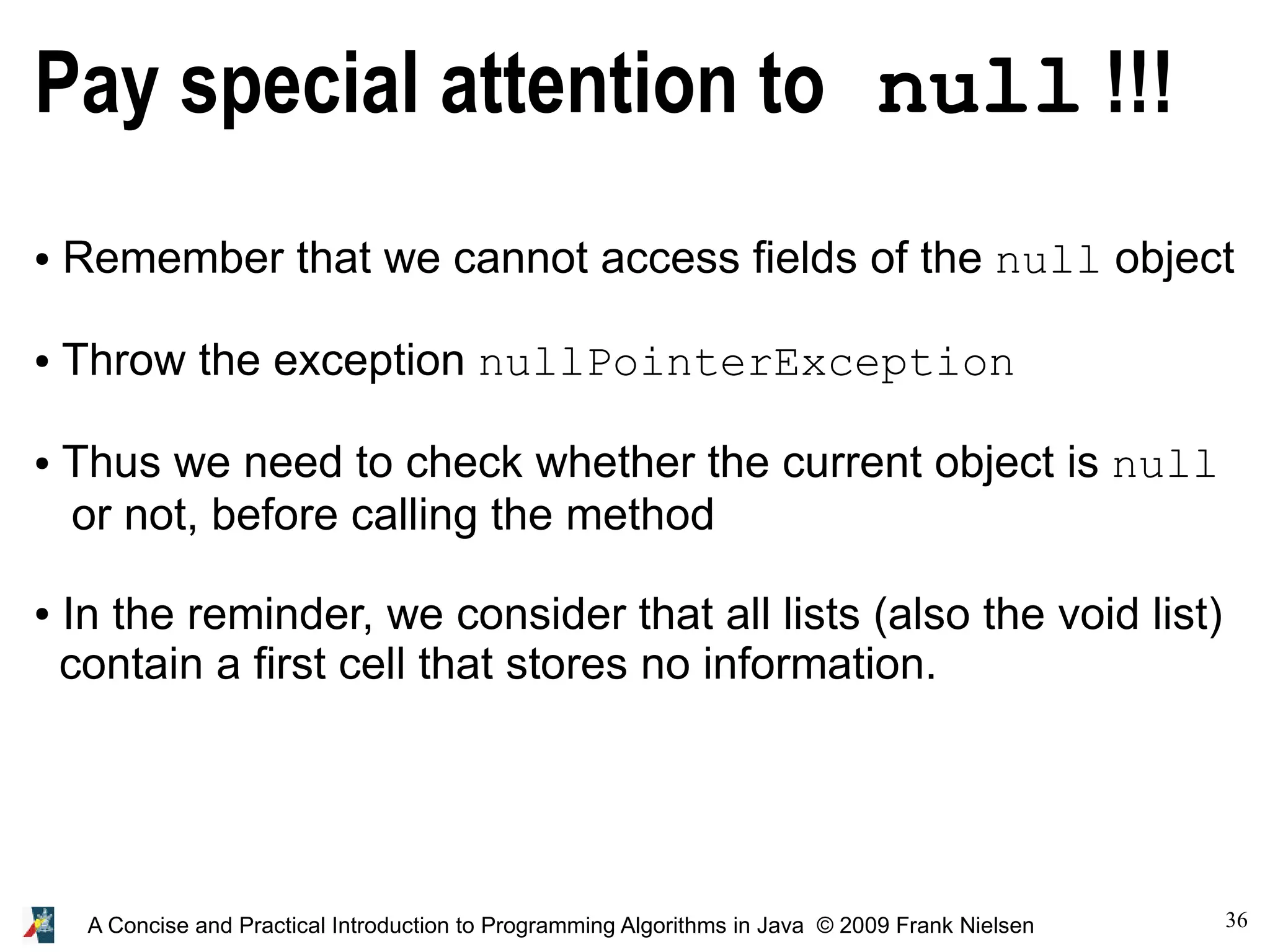
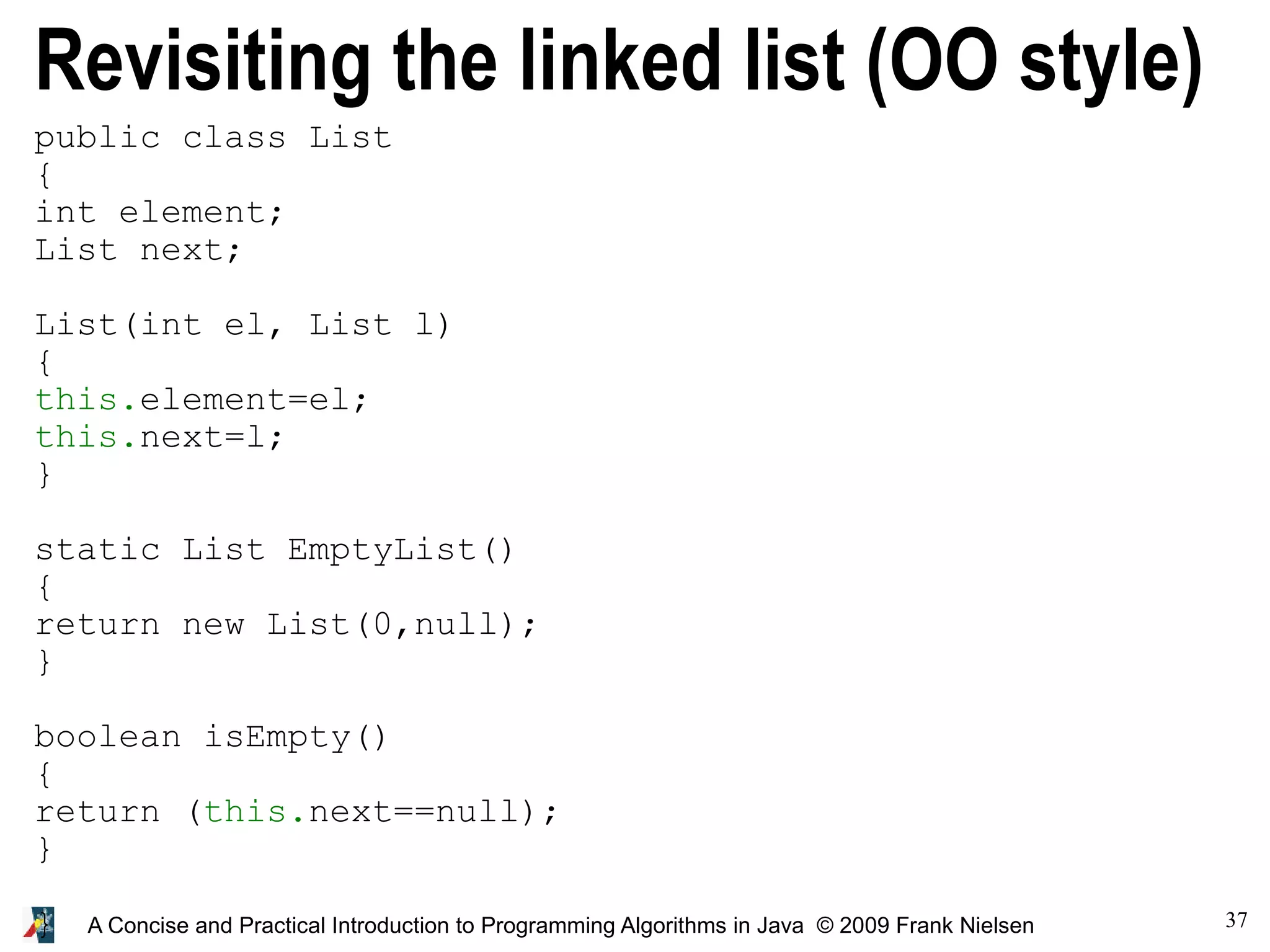
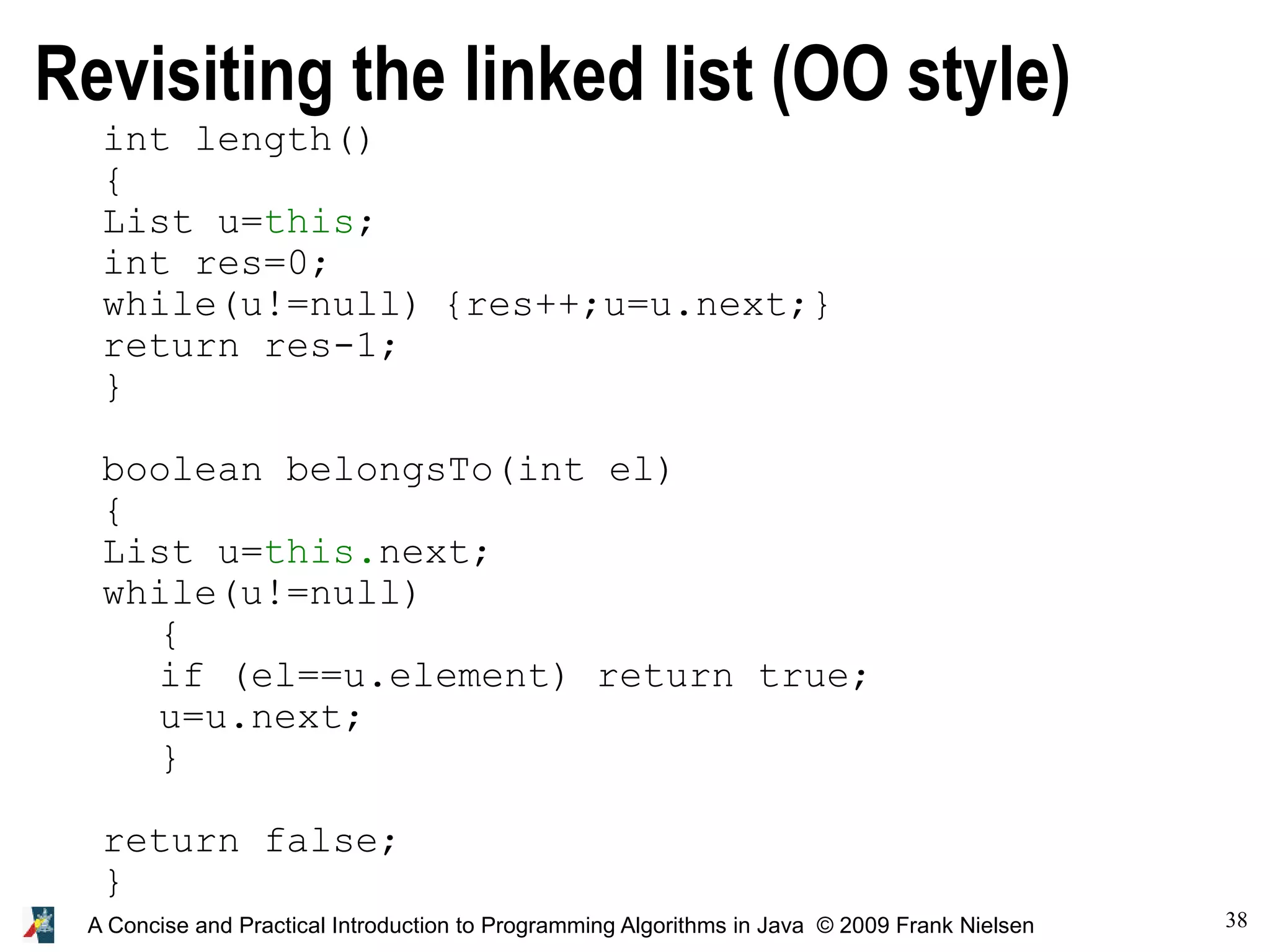
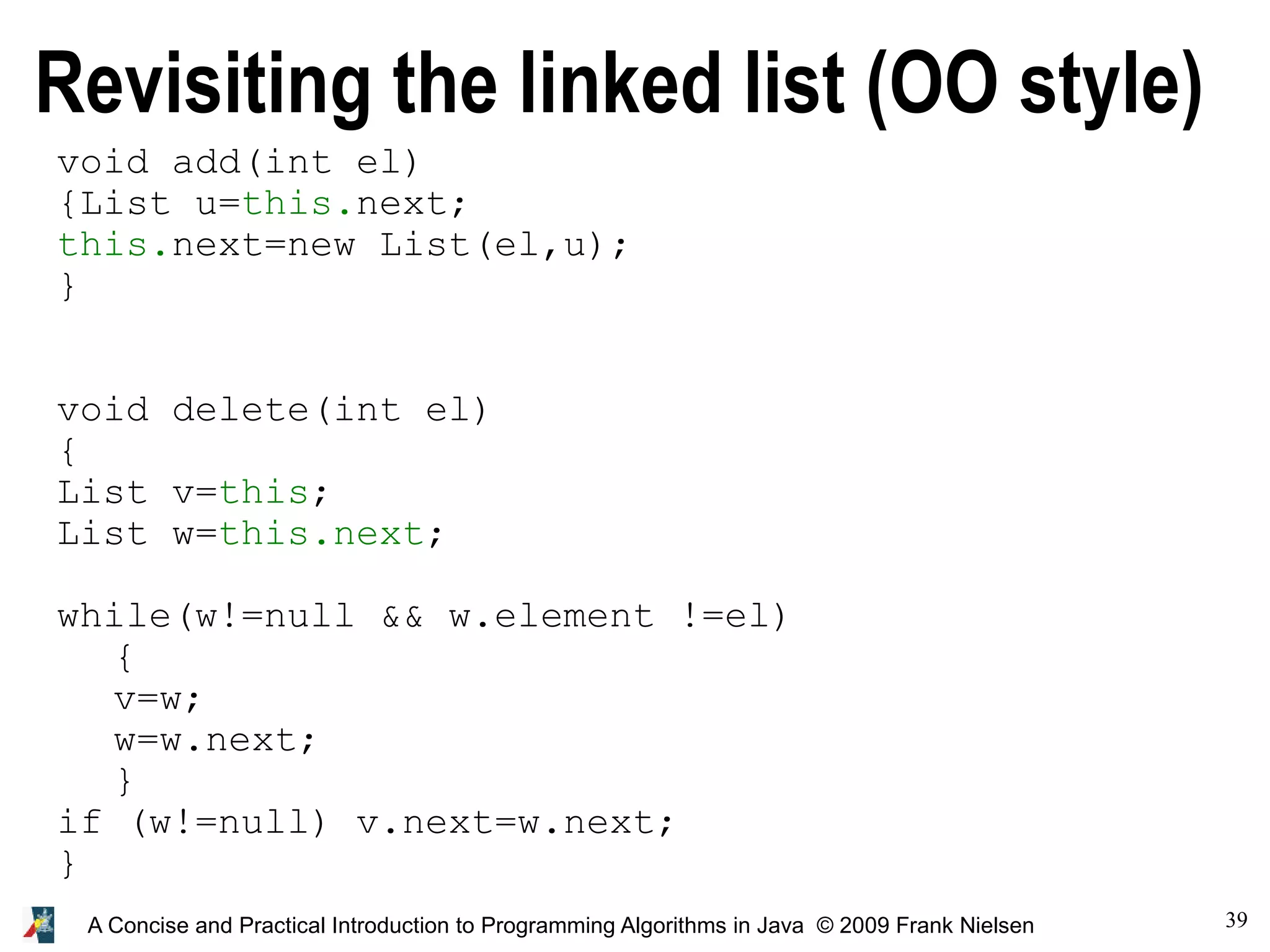
![40A Concise and Practical Introduction to Programming Algorithms in Java © 2009 Frank Nielsen void display() { List u=this.next; while(u!=null) {System.out.print(u.element+"->"); u=u.next;} System.out.println("null"); } static List FromArray(int [] array) { List u=EmptyList(); for(int i=array.length-1; i>=0; i--) u.add(array[i]); return u; } Revisiting the linked list (OO style)](https://image.slidesharecdn.com/programmingalgorithmsjava-8-140701005550-phpapp01/75/chapter-8-A-Concise-and-Practical-Introduction-to-Programming-Algorithms-in-Java-40-2048.jpg)
![41A Concise and Practical Introduction to Programming Algorithms in Java © 2009 Frank Nielsen Revisiting the linked list (OO style) public static void main(String[] args) { int [] array={2,3,5,7,11,13,17,19,23}; List u=FromArray(array); u.add(1); u.display(); u.delete(5); u.display(); System.out.println(u.belongsTo(17)); System.out.println(u.belongsTo(24)); }](https://image.slidesharecdn.com/programmingalgorithmsjava-8-140701005550-phpapp01/75/chapter-8-A-Concise-and-Practical-Introduction-to-Programming-Algorithms-in-Java-41-2048.jpg)
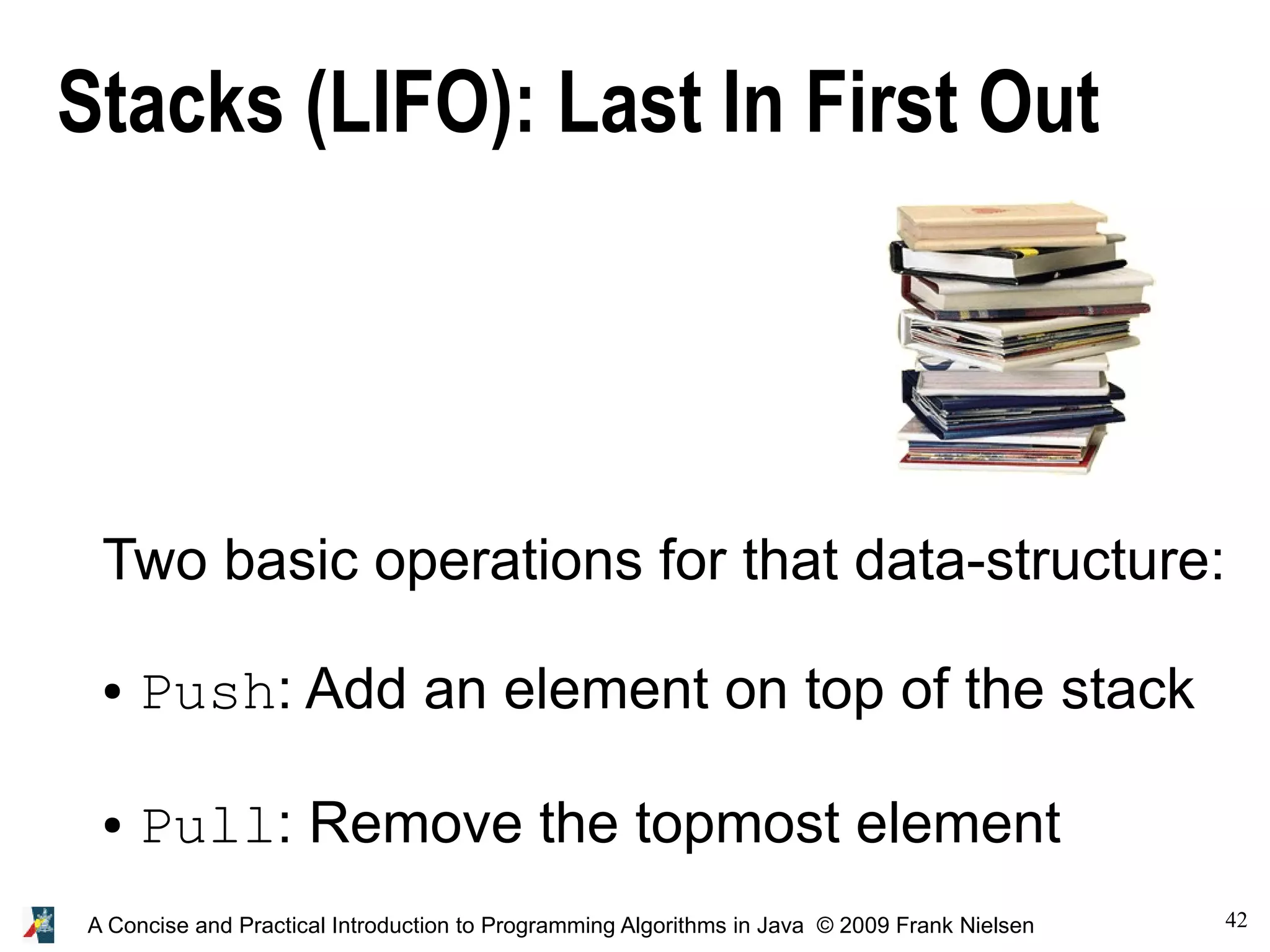
![43A Concise and Practical Introduction to Programming Algorithms in Java © 2009 Frank Nielsen Stacks (LIFO) using arrays class StackArray { int nbmax; int index; int [ ] array; // Constructors StackArray(int n) { this.nbmax=n; array=new int[nbmax]; index=-1; System.out.println("Succesfully created a stack array object..."); } // Methods void Push(int element) { if (index<nbmax-1) array[++index]=element; } int Pull() { if (index>=0 ) return array[index--]; else return -1; } }](https://image.slidesharecdn.com/programmingalgorithmsjava-8-140701005550-phpapp01/75/chapter-8-A-Concise-and-Practical-Introduction-to-Programming-Algorithms-in-Java-43-2048.jpg)
![44A Concise and Practical Introduction to Programming Algorithms in Java © 2009 Frank Nielsen class DemoStack{ public static void main(String [] args) { StackArray myStack=new StackArray(10); int i; for(i=0;i<10;i++) myStack.Push(i); for(i=0;i<15;i++) System.out.println(myStack.Pull()); }](https://image.slidesharecdn.com/programmingalgorithmsjava-8-140701005550-phpapp01/75/chapter-8-A-Concise-and-Practical-Introduction-to-Programming-Algorithms-in-Java-44-2048.jpg)
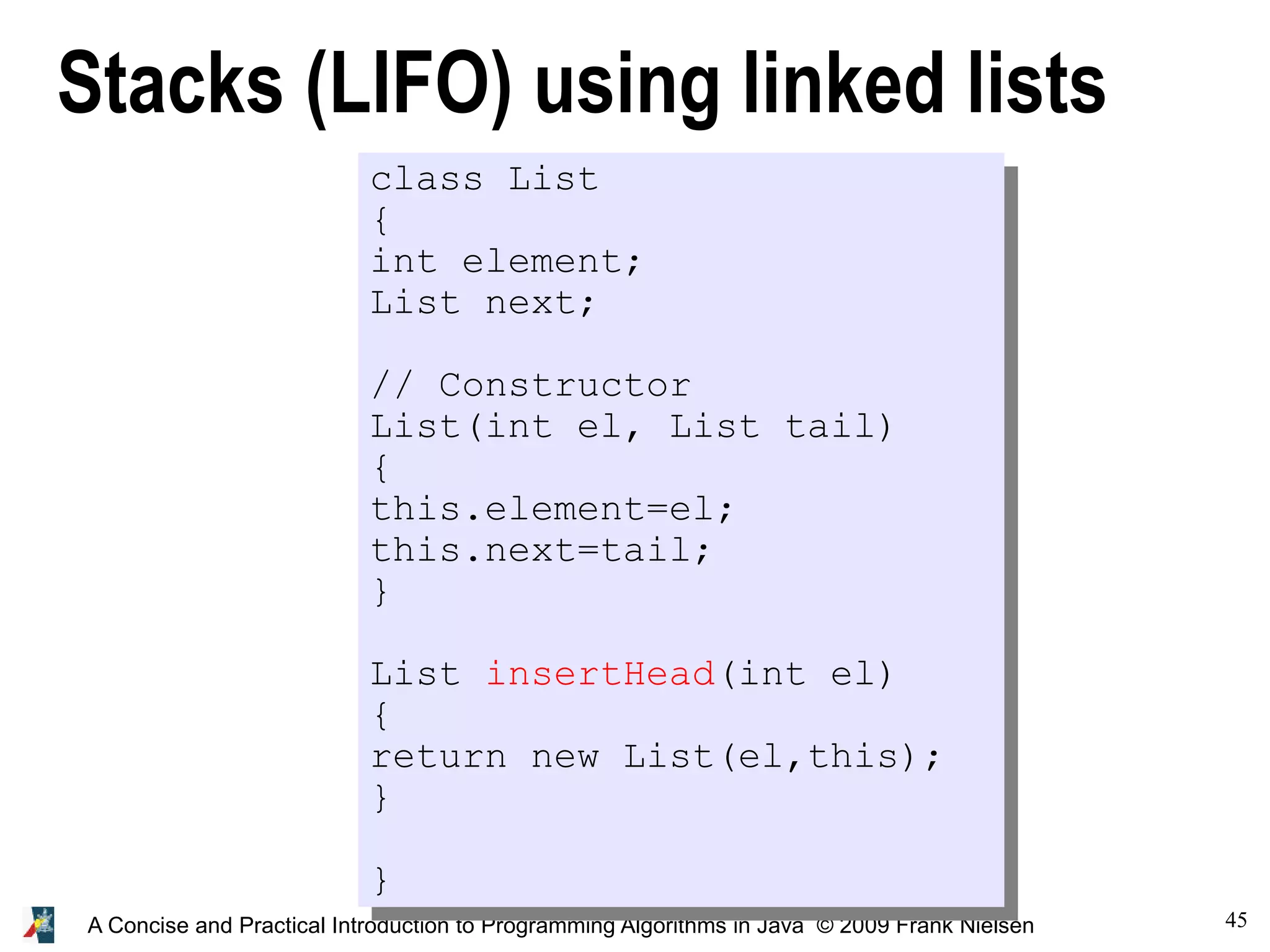
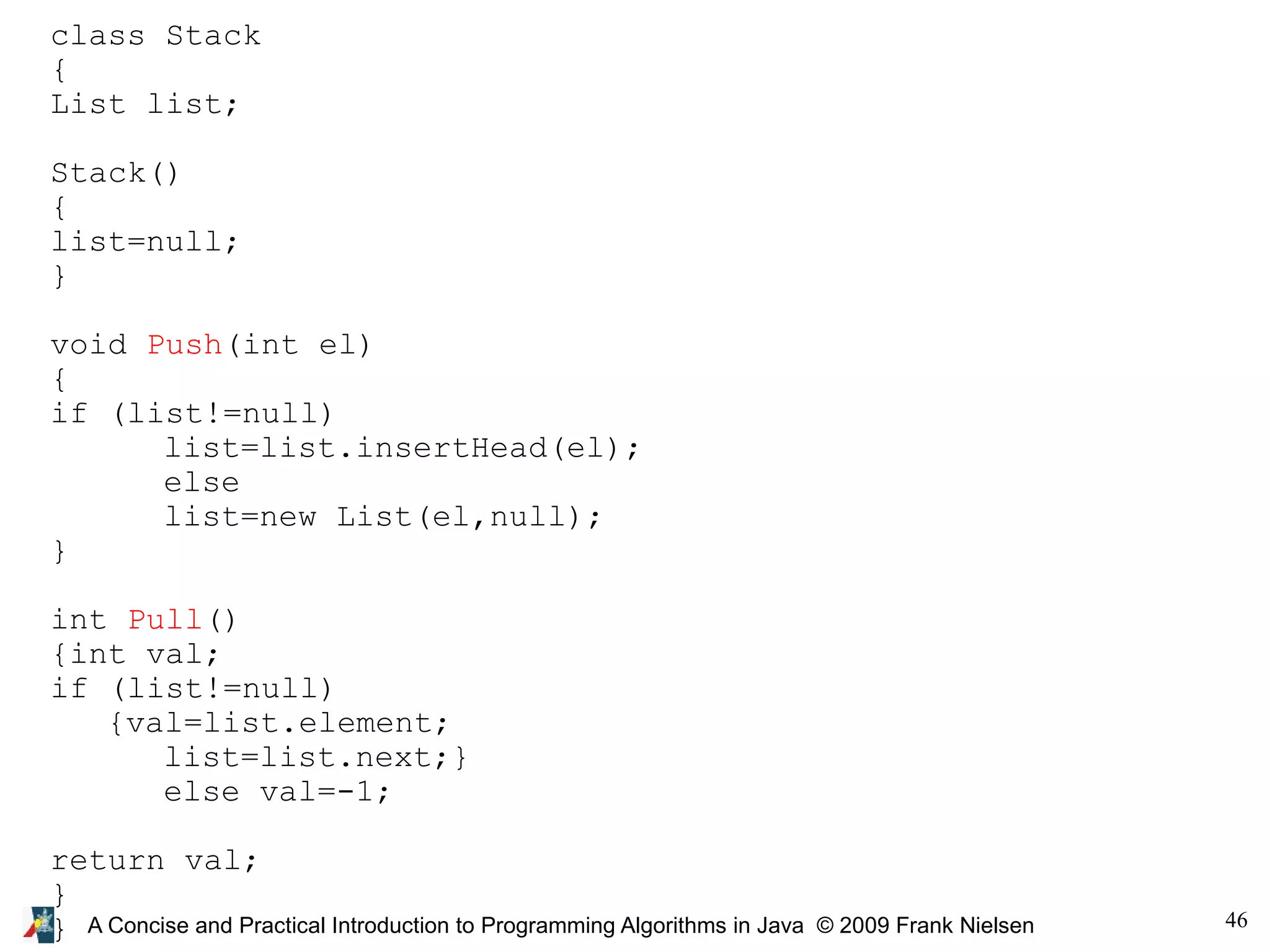
![47A Concise and Practical Introduction to Programming Algorithms in Java © 2009 Frank Nielsen // Use a Java package here import java.util.Stack; public class MainClass { public static void main (String args[]) { Stack s = new Stack(); s.push("A"); s.push("B"); s.push("C"); System.out.println(s); } } Stacks: API](https://image.slidesharecdn.com/programmingalgorithmsjava-8-140701005550-phpapp01/75/chapter-8-A-Concise-and-Practical-Introduction-to-Programming-Algorithms-in-Java-47-2048.jpg)
![48A Concise and Practical Introduction to Programming Algorithms in Java © 2009 Frank Nielsen class DemoStackList { public static void main(String [] args) { Stack myStack=new Stack(); int i; for(i=0;i<10;i++) myStack.Push(i); for(i=0;i<15;i++) System.out.println(myStack.Pull()); } } Stacks (LIFO) using linked lists Notice: Same code as StackArray demo program.](https://image.slidesharecdn.com/programmingalgorithmsjava-8-140701005550-phpapp01/75/chapter-8-A-Concise-and-Practical-Introduction-to-Programming-Algorithms-in-Java-48-2048.jpg)
